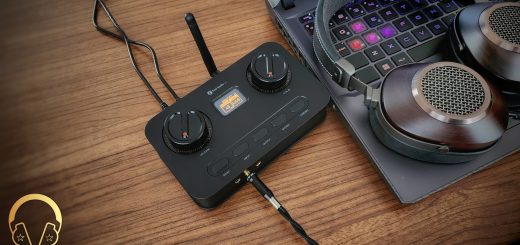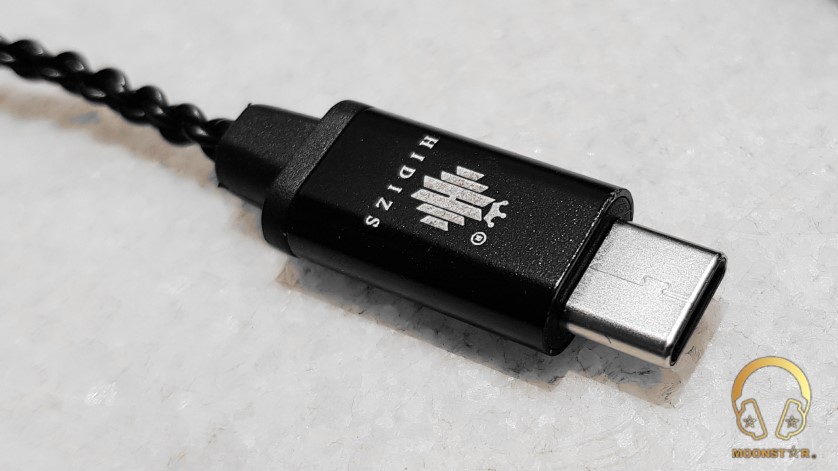Questyle SIGMA Review
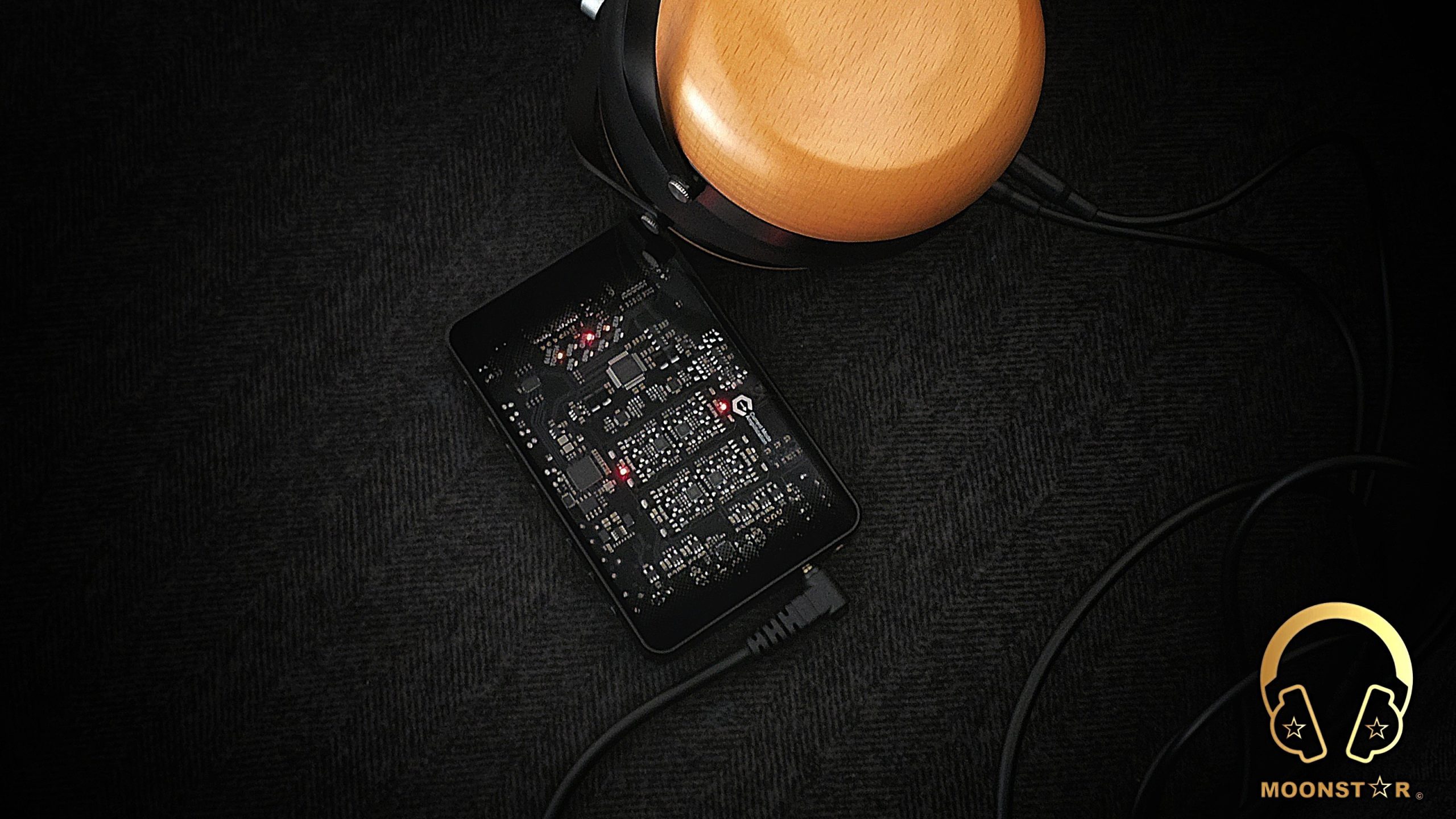
Questyle SIGMA Review
Introduction:
Questyle Audio is a company focused on the research and development of high-end audio systems. Their product portfolio includes a range of equipment such as desktop amplifiers (CMA800/CMA800R), DAC/amplifiers (CMA Twelve, CMA Fifteen, CMA 400i), wireless audio systems, portable DACs (M15, M12), and dedicated audio players (QPM, QP2R). The company has garnered attention within the industry, accumulating over 20 international awards since 2015, including recognition from organizations like the CES Innovation Award, iF Industrial Design Award, and VGP Lifestyle Award. Questyle maintains a strategic partnership with Foxconn Technology Group.
The Questyle SIGMA is presented as an ultra-portable DAC and headphone amplifier. The design reportedly inherits core technological principles from Questyle’s higher-end desktop units, specifically referencing the design philosophy of the CMA Eighteen Master. The key element is the use of the company’s patented Current Mode Amplifier (CMA) technology. This compact device integrates the AK4493 DAC and offers high-resolution decoding support up to PCM 768 kHz/32 bit and native DSD512. Its internal architecture utilizes four patented PCT (Pure Current Transfer) CMA circuits in a fully discrete, fully balanced configuration, alongside Questyle’s proprietary TTA (Triple Transformer Architecture) three-stage decoding system. These features are claimed to provide performance levels comparable to specialized desktop equipment. The SIGMA holds triple certification, covering Apple MFi, Snapdragon Sound, and Sony LDAC protocols.
This review will explore the device’s design, features, and sound performance to evaluate its claim of delivering high-quality audio performance in a small, portable package.
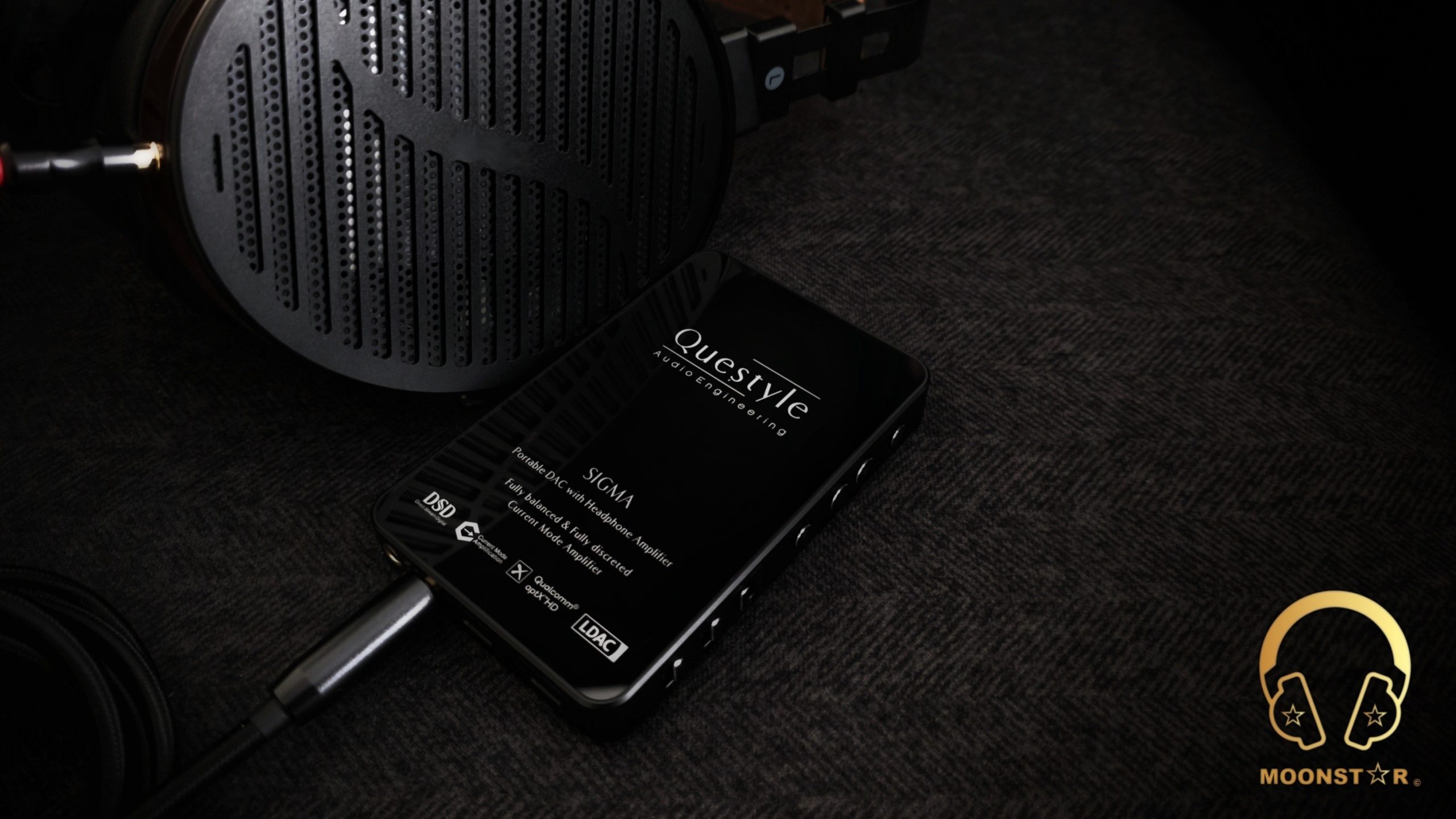
Disclaimer:
I would like to thank Questyle for providing me the SIGMA as review sample. I am not affiliated with Questyle beyond this review and these words reflect my true and unaltered opinions about the product!
Price & Availability:
The Questyle SIGMA has a current MSRP of 599 USD. This pricing places it within the premium portable DAC/Amplifier category, reflecting both its technical capabilities and build quality. Additional product details and specifications are available through the official link provided below.
Package & Accessories:
The Questyle SIGMA is delivered in a rectangular black box that conveys a premium aesthetic. This primary packaging is further encased in an outer white cardboard sleeve. The sleeve features an illustration of the product, accompanied by the brand’s logo and essential product information.
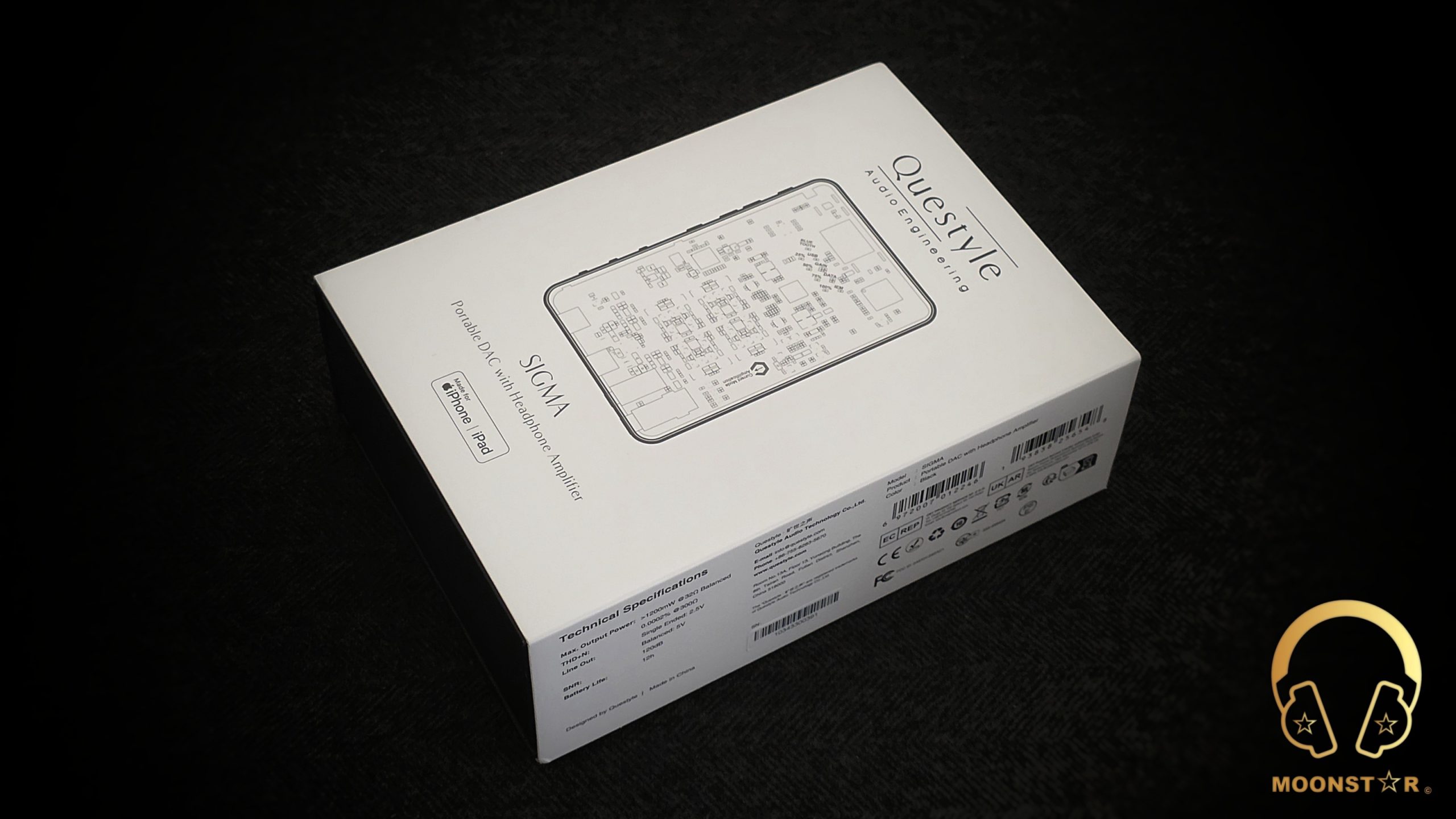
The box contains the following contents and accessories:
- 1 x Questyle SIGMA Portable USB DAC/Amplifier
- 1 x USB Type-C to USB Type-C Low Profile Cable
- 1 x USB Type-A to USB Type-C Cable
- 1 x USB Type-C to USB A Adapter
- 1 x Print Material (Instruction Manual & Guarantee Card)
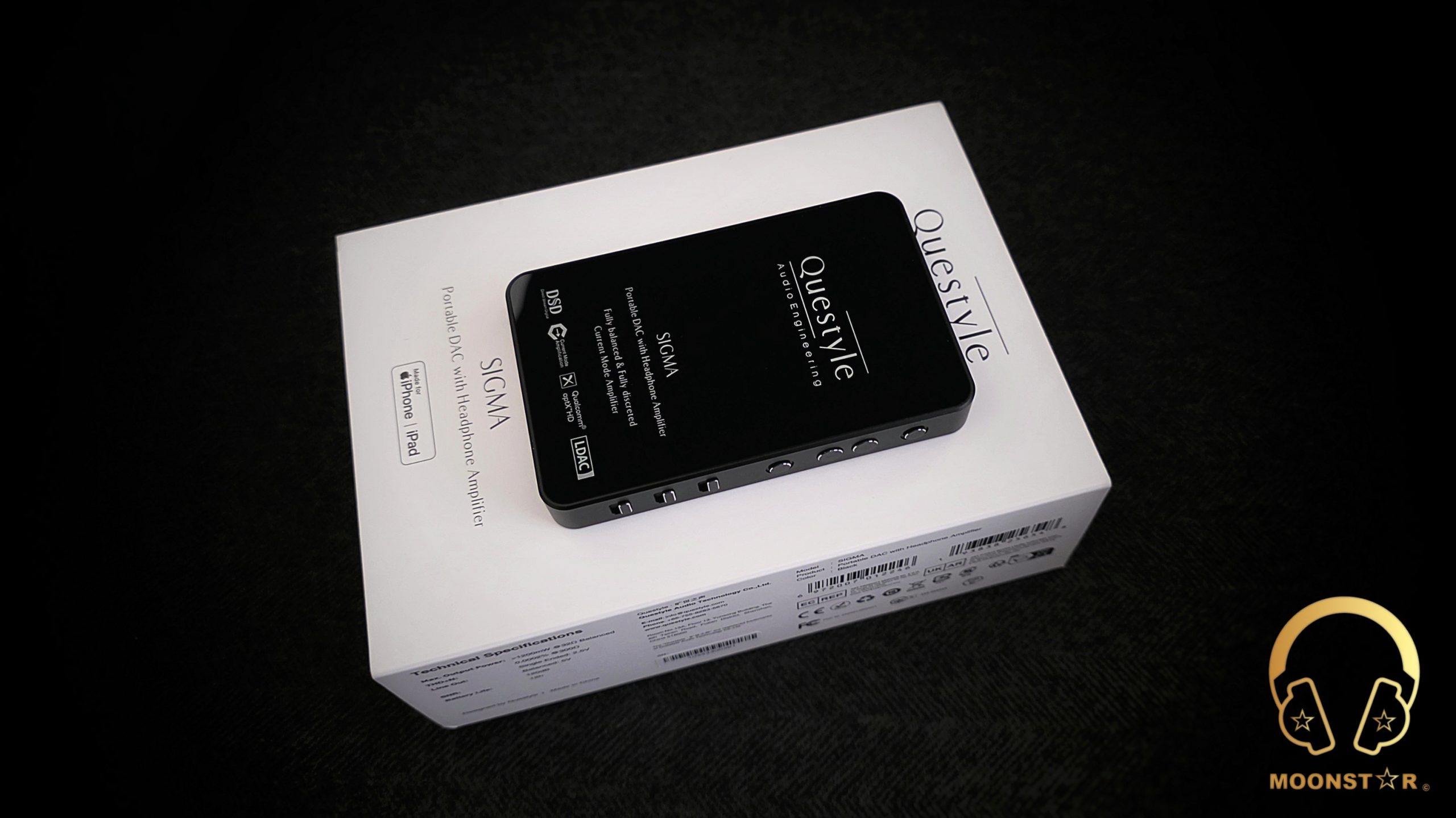
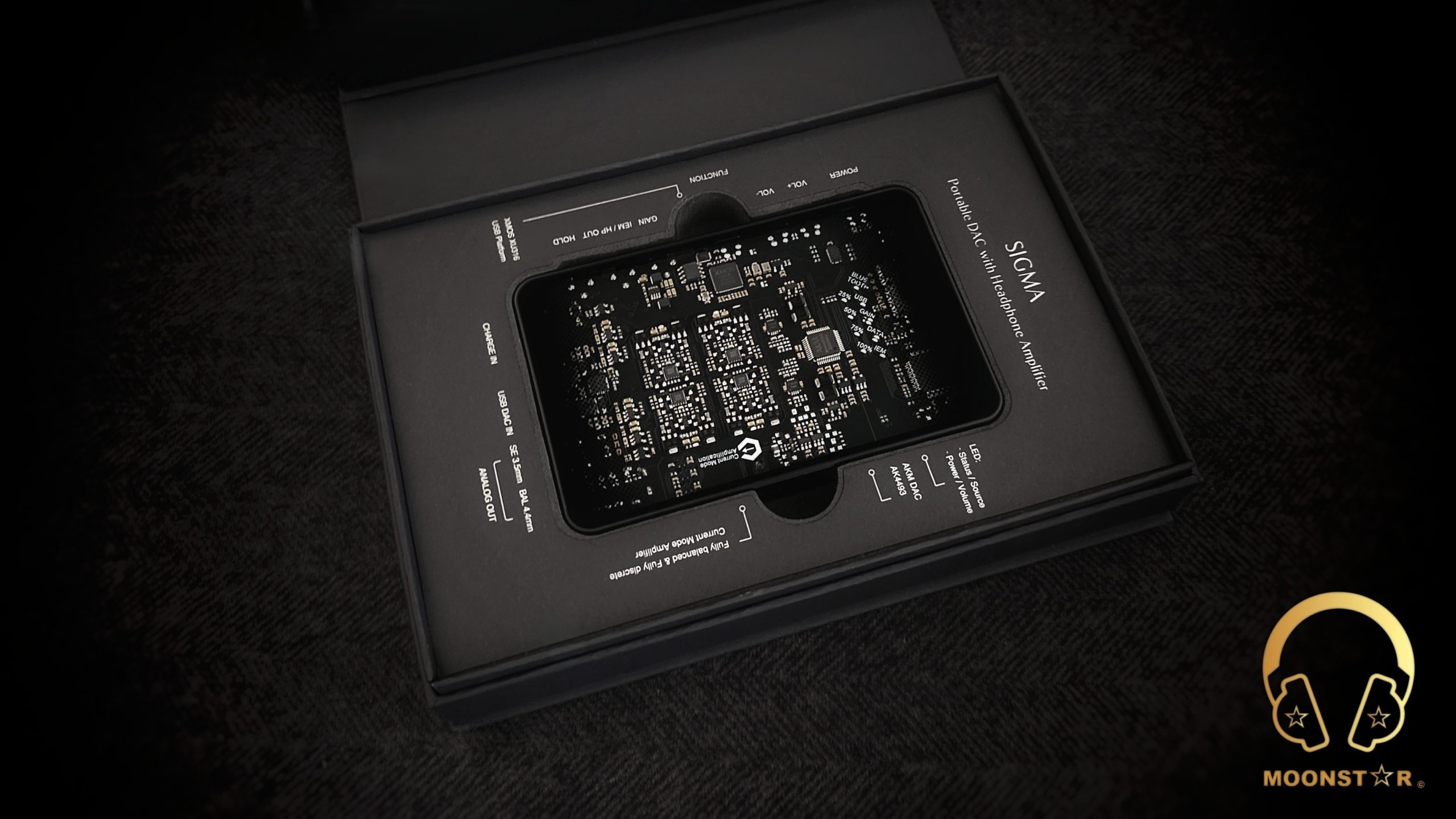
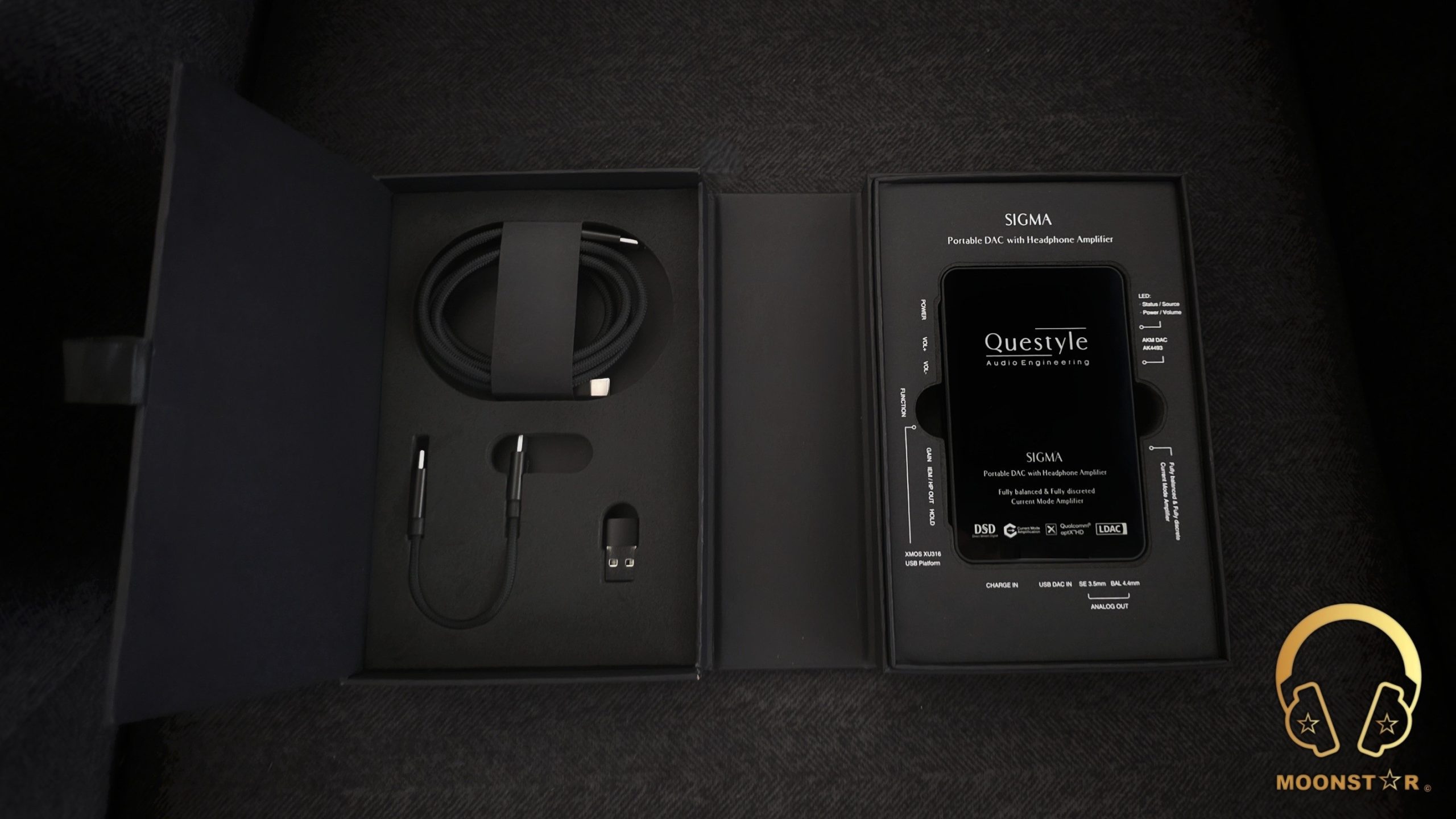
Design & Build Quality:
The Questyle SIGMA is crafted from sandblasted aviation-grade aluminum paired with optical-grade transparent glass panels. Weighing under 200g, it feels lightweight yet reassuringly solid, making it suitable for both portable and desktop use. The exterior embraces a minimalist design: a CNC-machined matte black aluminum frame contrasted by glossy glass surfaces. Gradient dot-matrix etching adds visual depth, while the RF suppression coating reflects a commitment to signal integrity.

The front panel’s transparent glass immediately draws attention, offering a clear view of the internal PCB. The layout is clean and deliberate, showcasing the XMOS XU316 microcontroller, AK4493 DAC chip, and Questyle’s proprietary Current Mode Amplifier architecture.
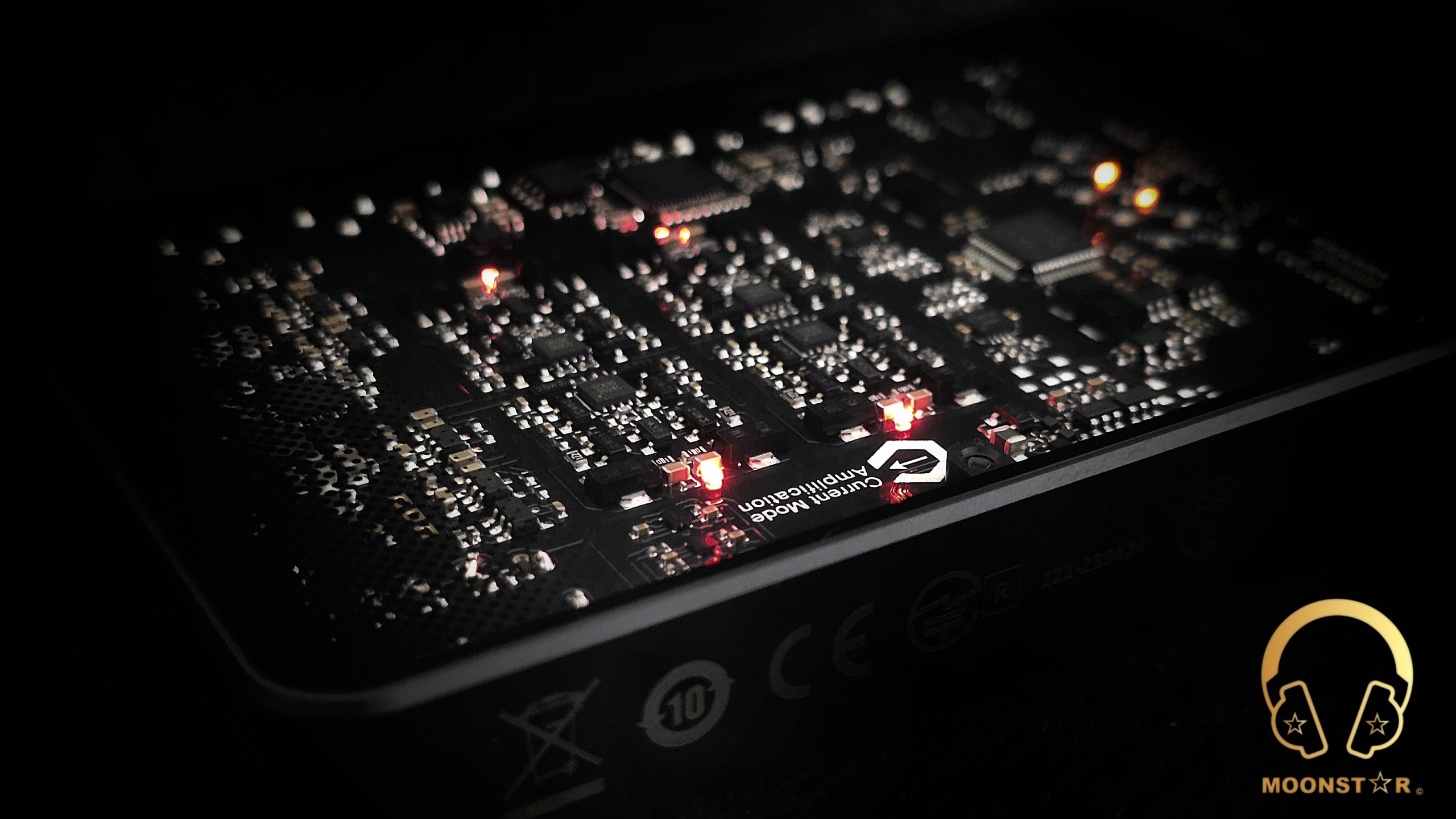
During playback, internal LEDs illuminate the circuitry, creating a visually engaging and functional aesthetic. These retro‑inspired LED accents recall classic audio gear while enhancing the modern industrial design.
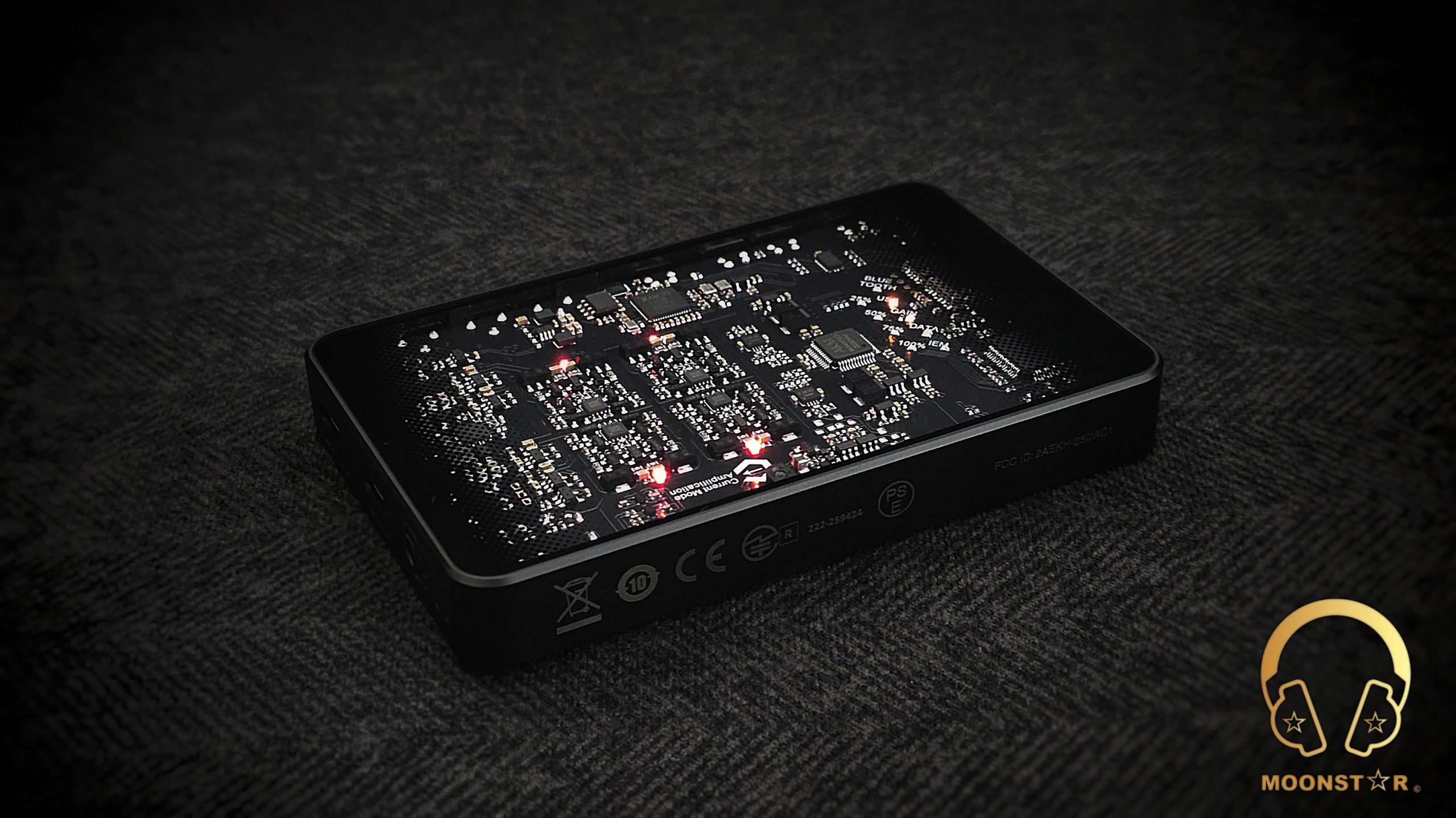
System status and battery/volume levels are communicated via integrated LED indicators. Each mode is color-coded for clarity: Bluetooth (flashing for pairing, solid for connection), USB (amber), Gain (red for High, amber for Standard), Data (red for Hi-Res, amber for Normal), and IEM (amber). Battery and volume are tracked by four amber LEDs, each representing charge levels and fine volume increments. A separate indicator confirms USB data connection.

On the side panel, physical controls are arranged logically and offer satisfying tactile feedback. Volume adjustment is smooth, supporting both incremental and continuous changes.
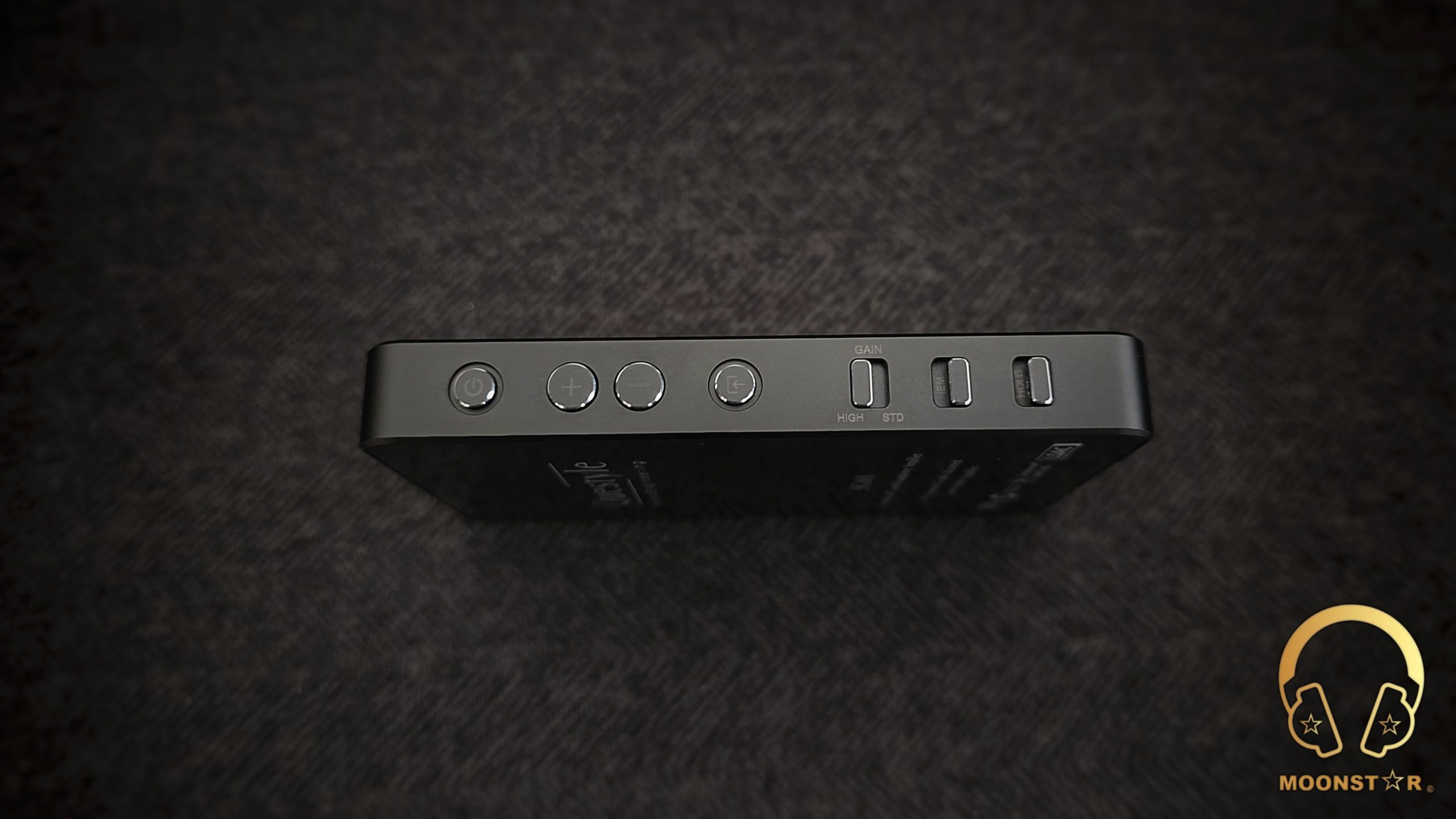
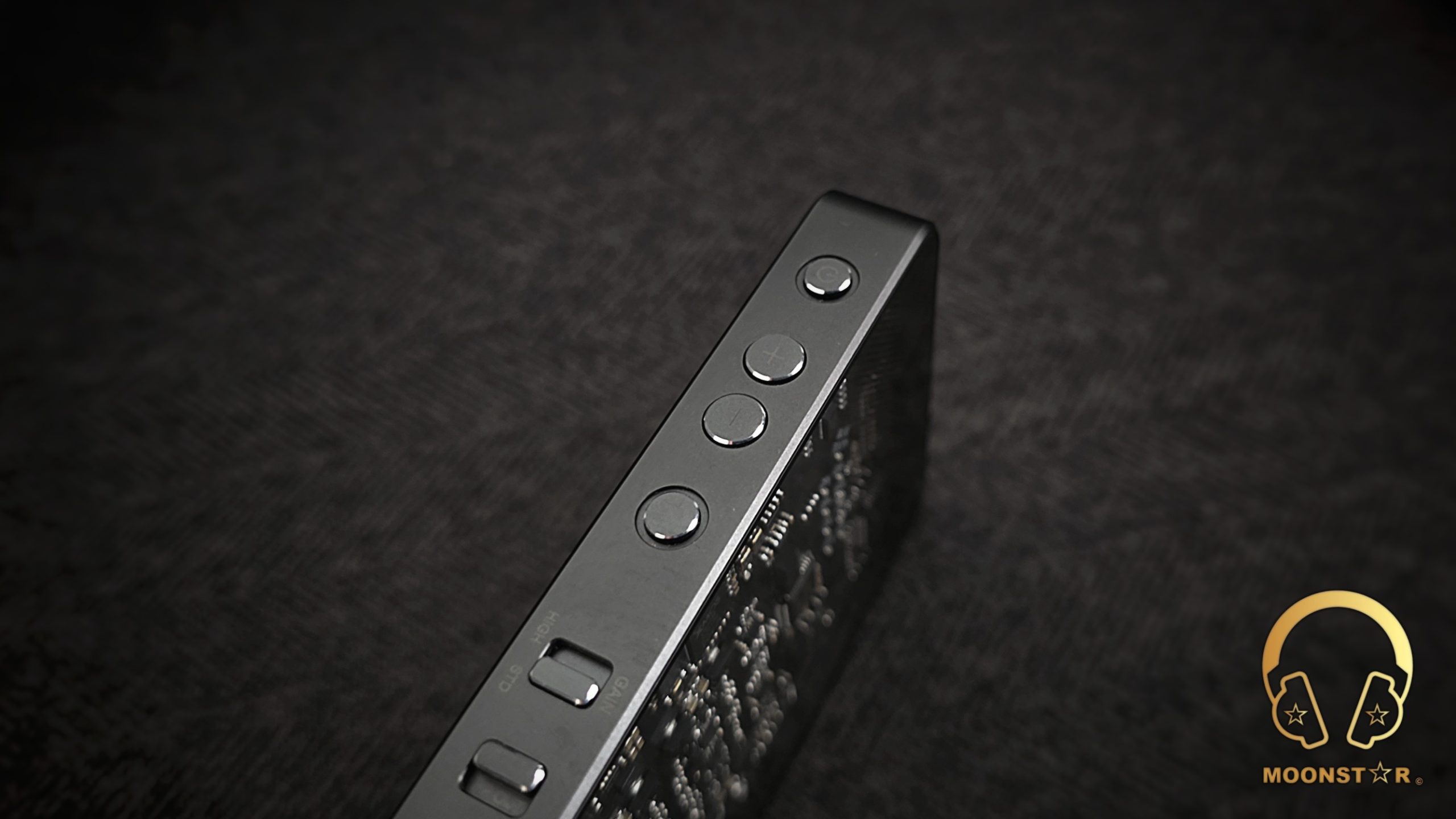
The Gain Switch, HOLD Switch, and Output Switch provide clear configuration options based on headphone type and sensitivity.
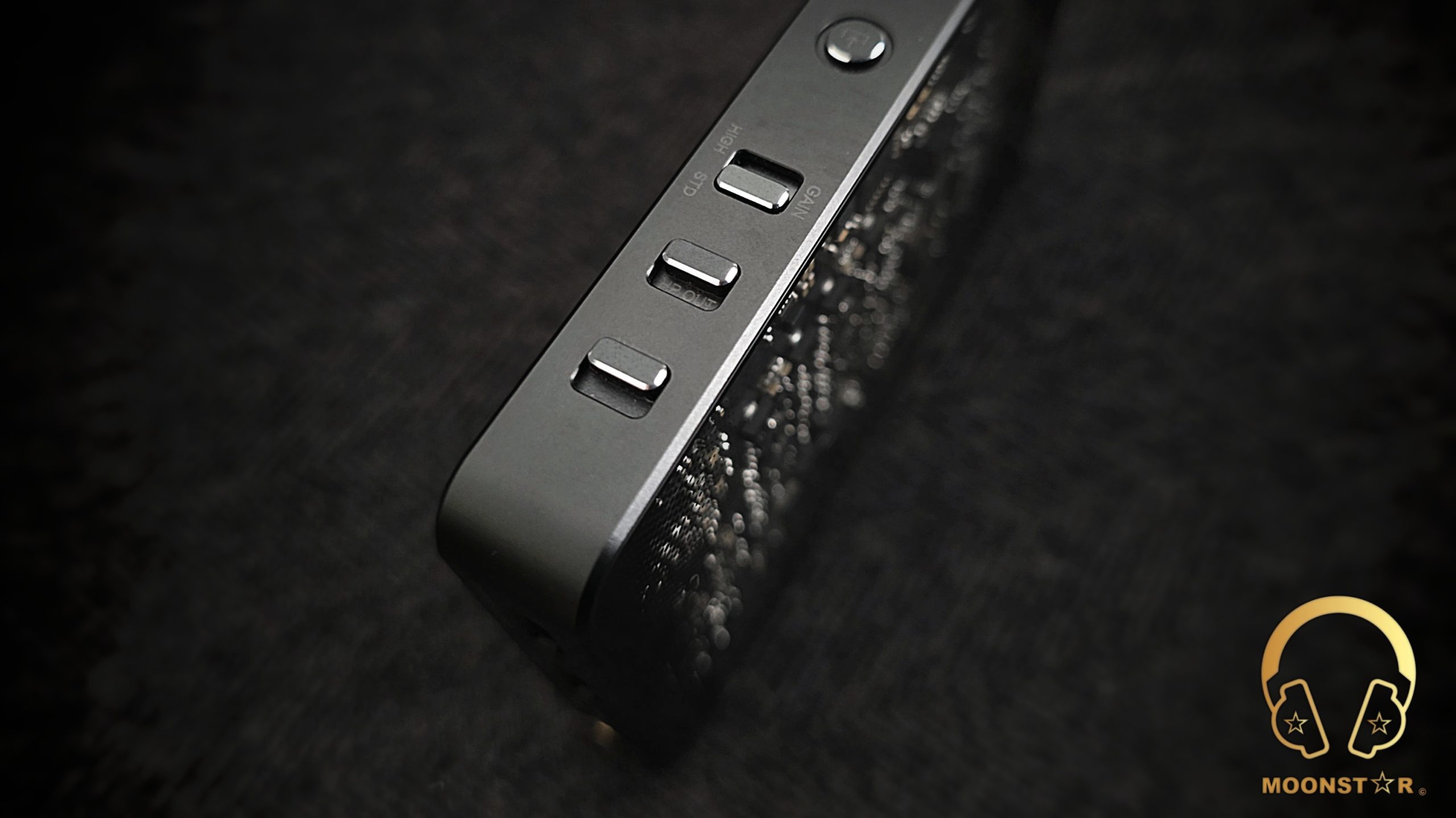
The bottom panel houses the connectivity ports: USB DAC IN, a 4.4 mm balanced output, a 3.5 mm single-ended output, and a dedicated USB charging port (5V/2A).
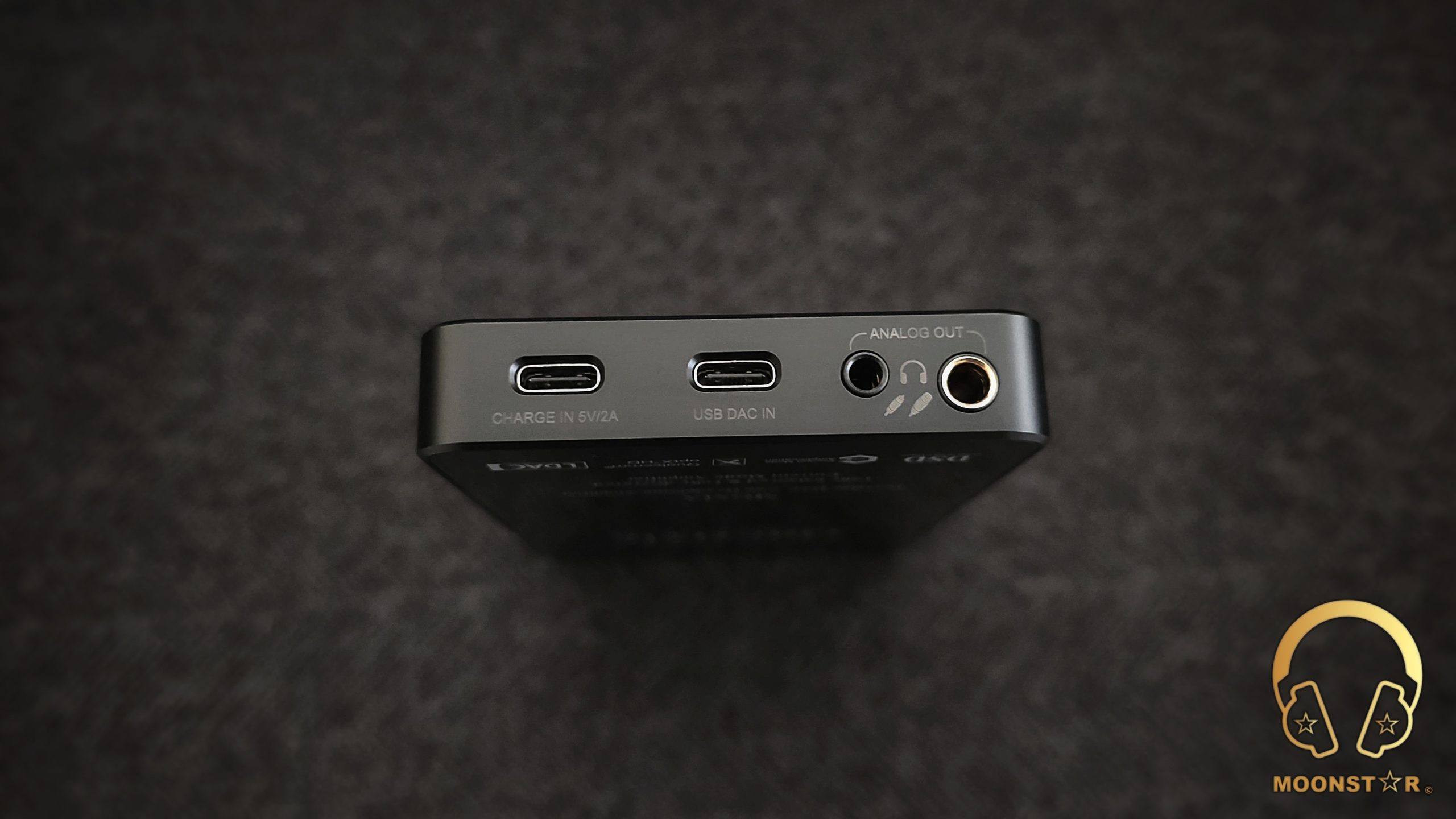
The rear panel mirrors the front, again featuring transparent glass. Branding and certifications such as MFi, LDAC, and Snapdragon Sound are prominently displayed, reinforcing broad compatibility. The gradient dot pattern enhances both aesthetics and RF shielding.
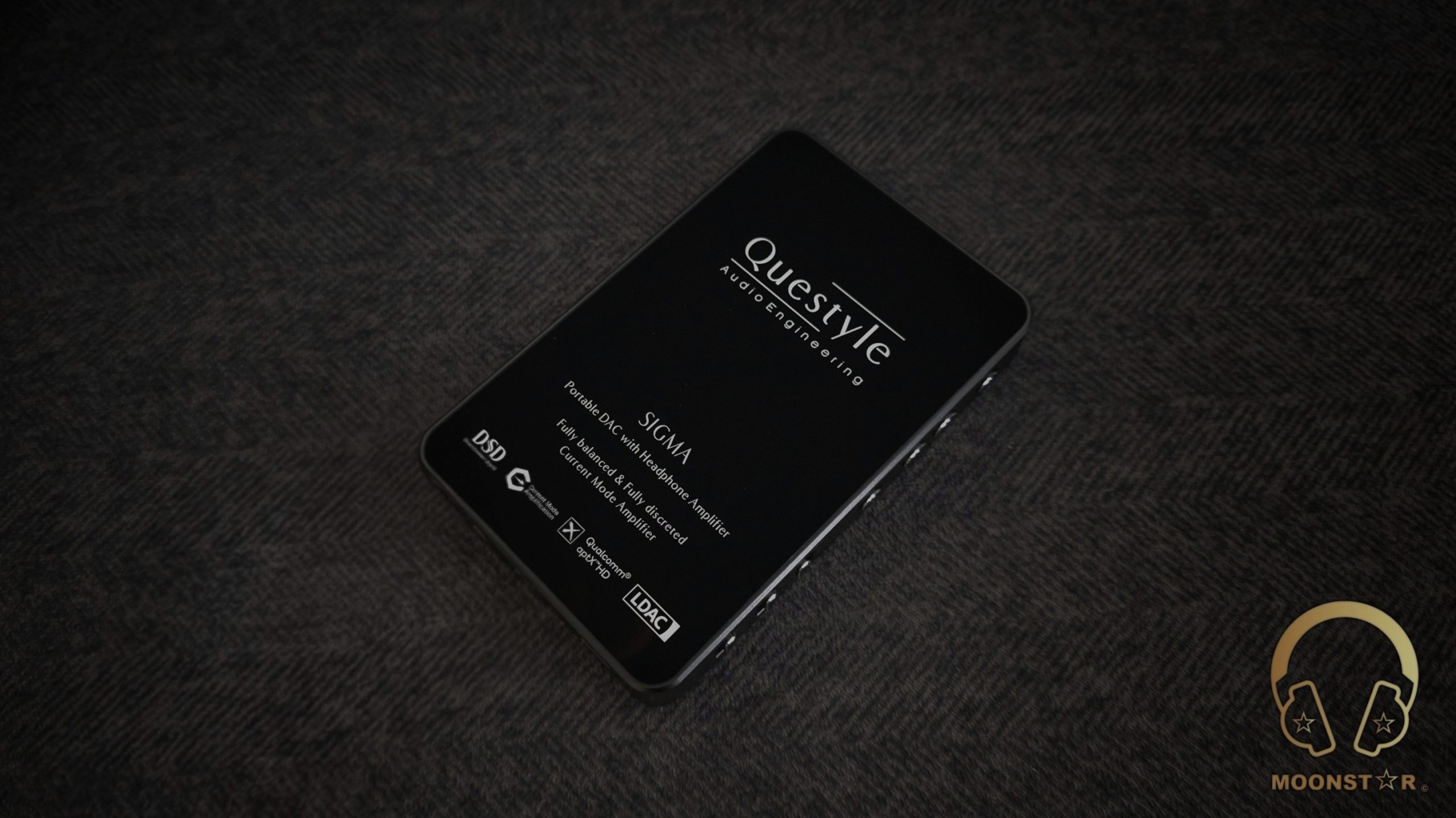
Upon close inspection, the build quality reveals no flex or gaps. Every design choice reflects precision engineering, where form and function are seamlessly integrated.
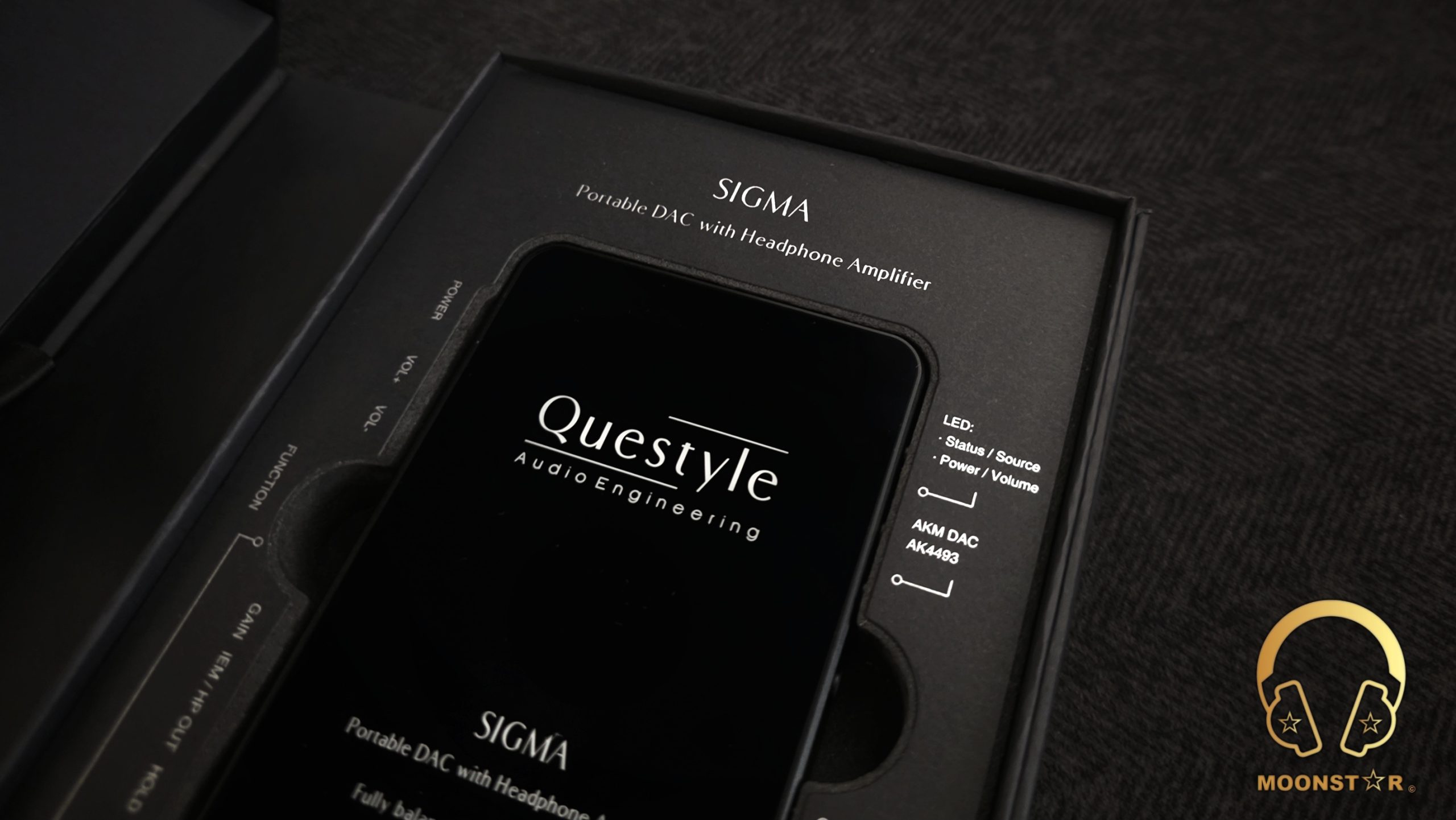
Technical Specifications:
- Model: SIGMA
- DAC Chip: AK4493
- PCM: 768 kHz/32 bit
- DSD Native: DSD64, DSD128, DSD256, DSD512
- DSD DoP: DSD64, DSD128, DSD256
- Micro Controller: XMOS XU316
- USB Playback: UAC 2.0 supported
- Supported OS: Win XP/Vista/Win7/Win8/Win10/Win11, Linux, Android, HarmonyOS, macOS, iOS (MFi certified)
- Bluetooth Codecs: SBC, AAC, aptX, aptX HD, LDAC
- THD+N: <0.0003% @20 mW, 300 Ω
- SNR: 120 dB
- Max Output Power: 1200 mW @ 32 Ω (4.4 mm Balanced)
- Line Out: Single-Ended >2.5 V, Balanced >6.8 V
- Playback Battery Life: >12 hours (real-world average 12-14 hours depending on gain and volume)
- Max Charging Current: 2 A (5 V input)
- Charging Time: ~3.5 hours
Hardware Features:
The Questyle SIGMA uses the same digital foundation that powers Questyle’s flagship CMA Eighteen Master desktop amplifier. An XMOS XU316 microcontroller handles the USB interface and supports PCM sampling rates up to 768 kHz at 32-bit depth as well as native DSD64 through DSD512 without conversion to PCM. The actual digital-to-analogue conversion is performed by a single AKM AK4493S VELVETSOUND™ DAC chip operating in fully balanced mode. Questyle complements this DAC with their proprietary TTA (Triple Transformer Architecture) three-stage re-clocking and filtering system, which effectively suppresses jitter regardless of source quality. Measured total harmonic distortion plus noise remains below 0.0003 % across the audible band, and the noise floor in laboratory conditions reaches approximately −130 dB (A-weighted) when the IEM mode is engaged.

Current Mode Amplification (CMA):
The Questyle SIGMA’s performance is founded on its proprietary Current Mode Amplifier (CMA) technology, a distinct architectural choice that departs significantly from traditional voltage-based amplification. This method converts the audio signal to current, amplifies it in that domain, and then reverts it to voltage at the output. Compared to conventional approaches, CMA inherently offers advantages in lower distortion and improved efficiency, factors that contribute directly to cleaner sound quality and potentially enhanced battery longevity. Supporting this technology is substantial output power, delivering up to 1200 mW @ 32 ohms via the 4.4 mm balanced output in High Gain mode. The balanced connection is implemented to minimize interference, aiming for a purer experience, while a standard 3.5 mm single-ended output is included for compatibility.
The SIGMA’s driving capabilities represent a significant performance upgrade over many portable devices. A functional enhancement is the dedicated IEM/HP OUT switch. When set to IEM mode (amber LED), the output impedance and gain are adjusted for low-impedance, high-sensitivity monitors, designed to optimize noise performance. In HP OUT mode (LED off), the circuit is reconfigured for high-impedance, low-sensitivity headphones, providing maximum voltage and current output.

The dedicated HP OUT and High Gain settings provides the necessary power to capably handle demanding planar magnetic headphones. When paired with the HiFiMAN Sundara CB, the resulting sound quality reaches a level competitive with dedicated desktop stacks. Sonically, this power manifests as tight, fast, and highly textured bass response. Dynamics exhibit a powerful, uncompressed swing.
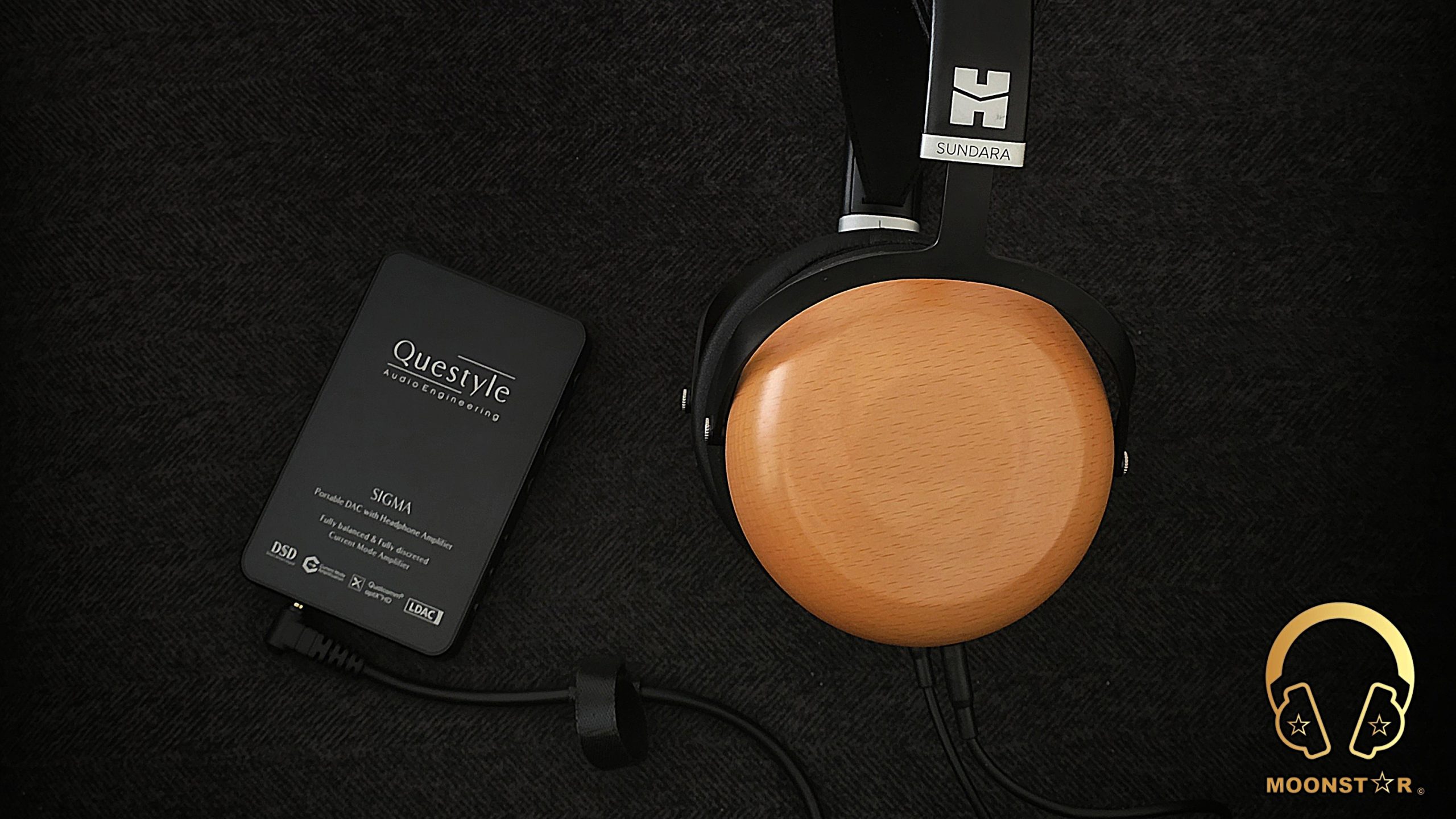
Less sensitive headphones, such as the FOSI i5, also benefit, showing a noticeably widened soundstage and midrange that gains substantial body and warmth. This powerful performance does not sacrifice silence; switching to IEM mode with sensitive in-ear monitors reveals a remarkably clean signal path.
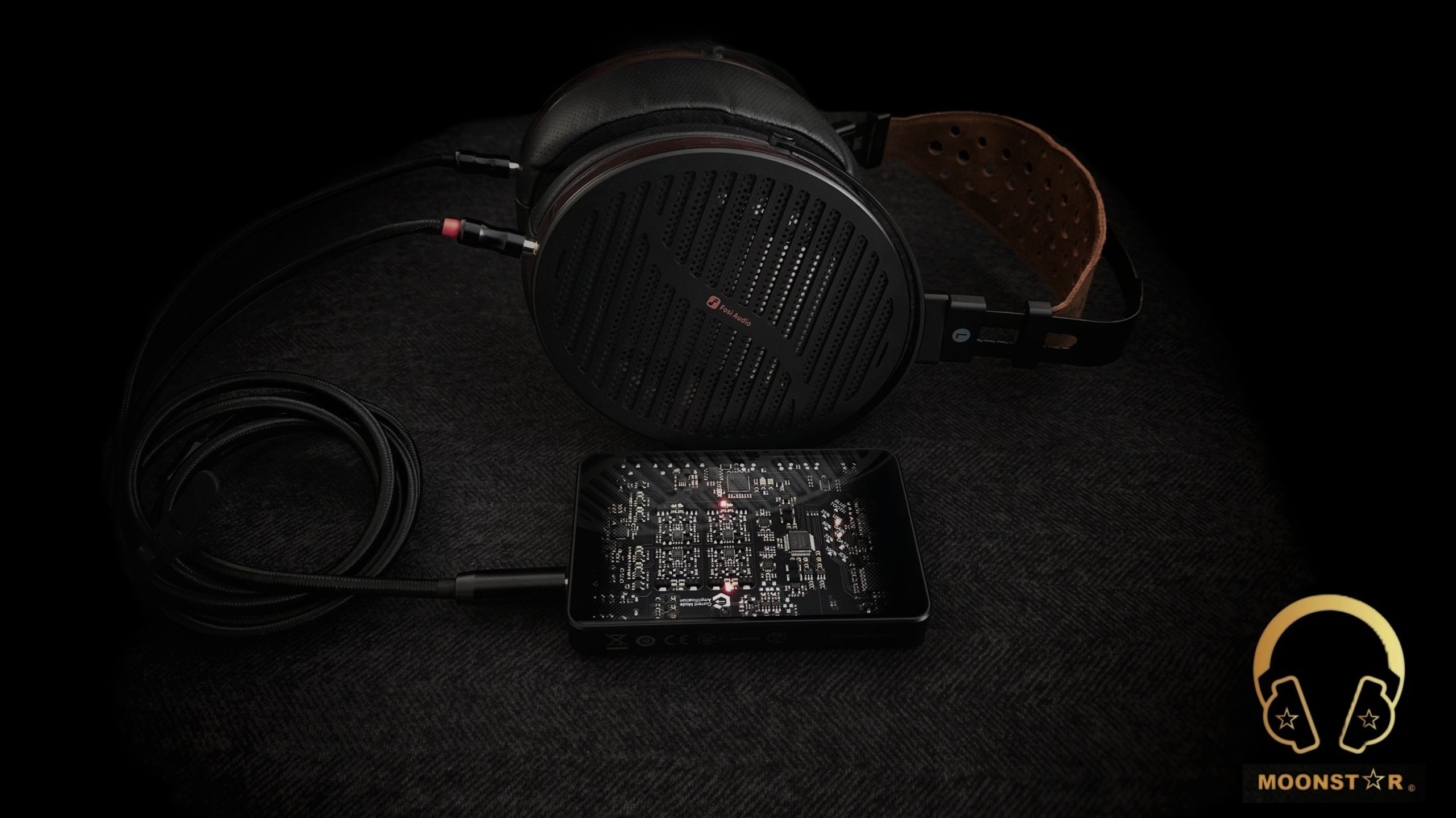
The background noise floor is very low and much better in terms of performance compared to the CMA18P. Ultimately, the cumulative technical refinements in the SIGMA, which include the physical IEM/HP switch, increased power reserves, cleaner power supply, and smarter battery management, appear to be more than just marketing features. They translate into real, audible improvements that successfully address the specific weaknesses observed in its predecessor, the CMA18P. The manufacturer’s intent to refine the device based on user feedback is clearly evident in the final product.
Compatibility:
The SIGMA offers extensive system compatibility, supporting high-speed USB audio connectivity with both mobile and desktop platforms. Beyond wired performance, it incorporates lossless Bluetooth audio capability. The unit’s utility is expanded by its manually selectable output modes: a dedicated headphone amplifier setting and a fixed-level line-out mode. This latter feature allows the SIGMA to function as a standalone DAC, facilitating integration into a larger, existing Hi-Fi system, rather than being strictly limited to personal listening. The device is also claimed to enhance PC audio quality, particularly for bandwidth-intensive tasks such as live concert streaming, a feature we noted during testing.
The SIGMA maintained full functionality across all tested major mobile ecosystems (iOS, HarmonyOS, and Android 5.1 and newer). For desktop users, the device operates without incident on Windows 10 1803+ (requiring driverless installation) and macOS, ensuring reliable playback from major streaming services (Apple Music, Spotify, TIDAL, etc.) without the need for complex configuration

Bluetooth Connectivity:
The wireless experience on this unit is built upon a foundation of dedicated engineering, utilizing a dedicated Bluetooth 5.4 chipset for maximizing performance. The design cleverly incorporates an isolated ground plane to effectively mitigate electrical noise, a critical detail that successfully preserves audio integrity. Furthermore, signal stability is enhanced by a high-gain, physically separate antenna smartly located beneath the rear glass panel, away from potential internal interference.
The device delivers an exhaustive codec suite, essential for today’s diverse audio environments, including the premium LDAC standard (supporting up to 990 kbps at 96 kHz/24-bit), alongside aptX Adaptive, aptX HD, AAC, and SBC. This commitment to broad, high-quality compatibility is validated by securing triple certification across Qualcomm Snapdragon Sound, Sony LDAC, and Apple MFi protocols. In practical usage, the performance is genuinely impressive; open-office testing confirmed connection stability beyond 17 metres line-of-sight, and the signal maintained lock through two reinforced concrete walls at 11–12 metres, showcasing excellent penetrative power. Operationally, codec negotiation is reliably fast, and the front amber LED cluster is a welcome, immediate visual indicator of the active codec and bitrate (four LEDs equals LDAC 990 kbps).
Finally, latency is tightly controlled; video playback tests on diverse platforms, including the MSI Vector GP68 HX (Gaming Laptop) and the Samsung Galaxy S25 Ultra, was consistently solid, presenting no discernible lip-sync issues, making it entirely suitable for demanding media consumption.
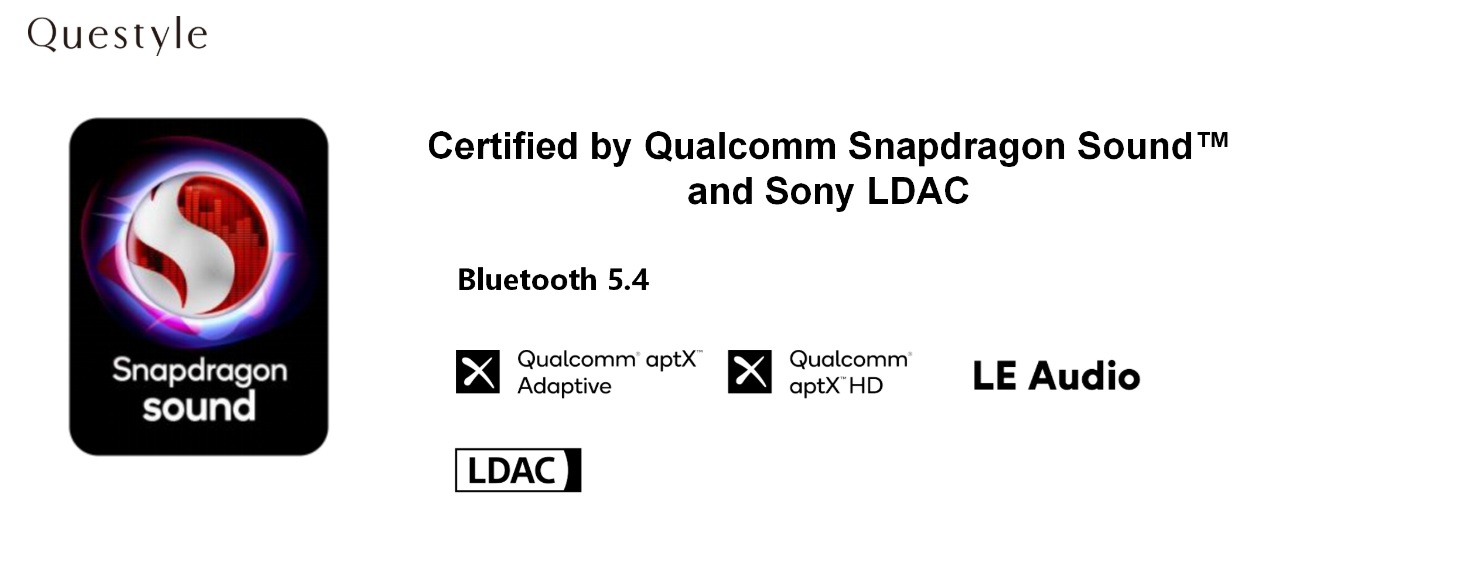
Battery Life:
The Questyle SIGMA is equipped with a 4300 mAh lithium battery and a special power management system. This combination offers up to 12 hours of continuous playback, which is above average performance for such a small and powerful device. However, battery life will vary depending on the output and gain mode selected.
The SIGMA offers flexibility in how it manages power while connected to a device via USB for data transfer (like computers, tablets, and phones). By default, it operates in “Play Only” mode. This means the SIGMA prioritizes using its internal battery for power while drawing audio data from the USB connection. This is a thoughtful design choice to prevent the SIGMA from draining the battery of your phone or other smaller playback devices.
Here are some details for battery life when the device is used in USB DAC mode:
- 3.5 mm Single-Ended Output: about 12 hours @ Standard Gain
- 3.5 mm Single-Ended Output: about 9–10 hours @ High Gain
- 4.4 mm Balanced Output: about 10 hours @ Standard Gain
- 4.4 mm Balanced Output: about 7–8 hours @ High Gain
The LED system keeps you informed about the device’s battery status. A quick press of the power button illuminates the lights, displaying the battery level for five seconds. Four glowing lights indicate a high charge (76-100%). Three lights represent a medium level (51-75%). Two lights signal it’s time to consider a recharge (26-50%). And a single light means only 1-25% battery remains, so you’ll need to plug in soon.
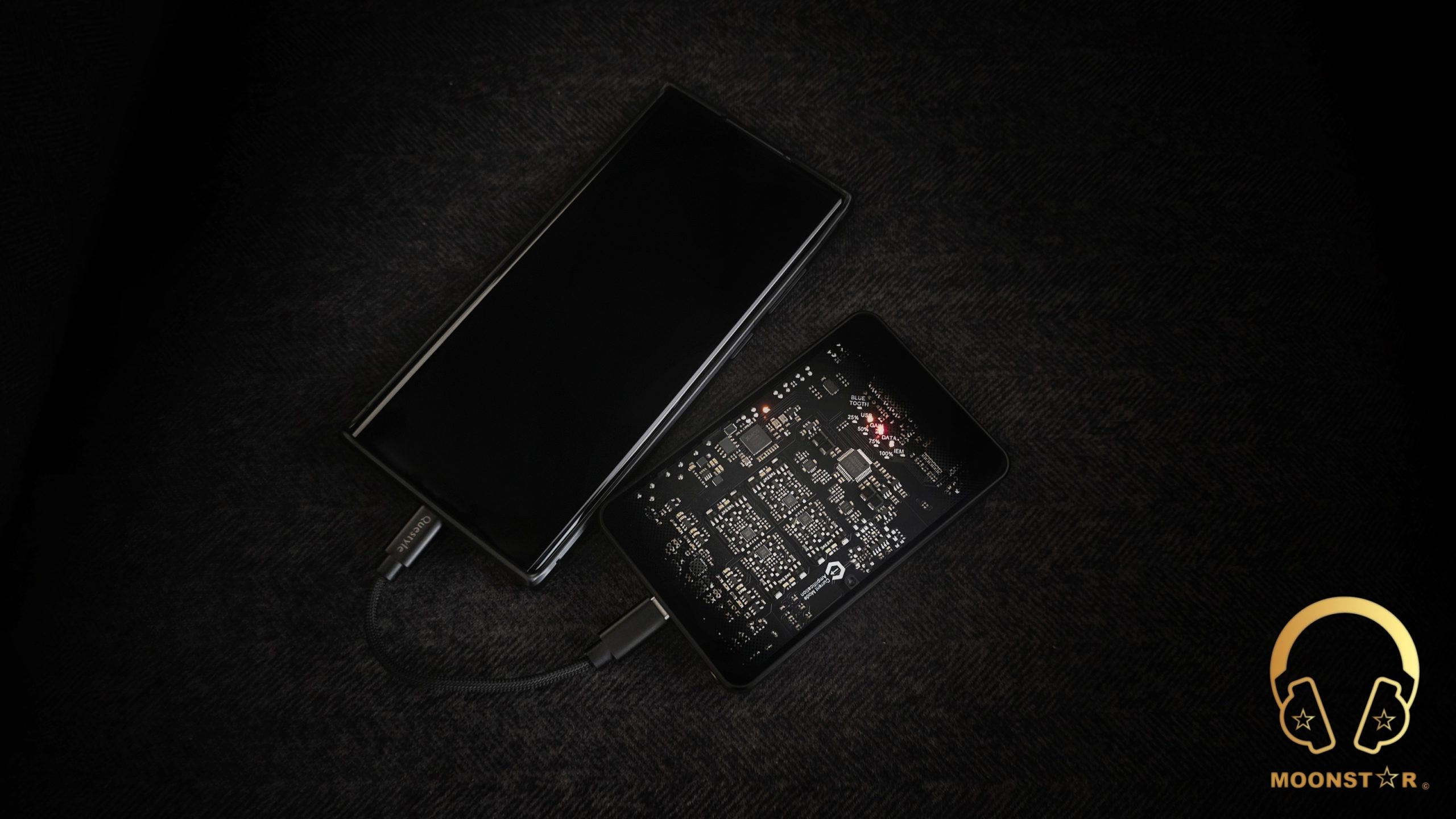
Equipment’s used for this review:
- DAC/AMP’s : Questyle SIGMA, Questyle CMA18P
- IEM’s : Oriveti OH700VB, Westone MACH 80
- Headphones : HiFiMAN Sundara CB, FOSI i5
- Sources : Samsung Galaxy S25 Ultra, MSI Vector GP68 HX 13V
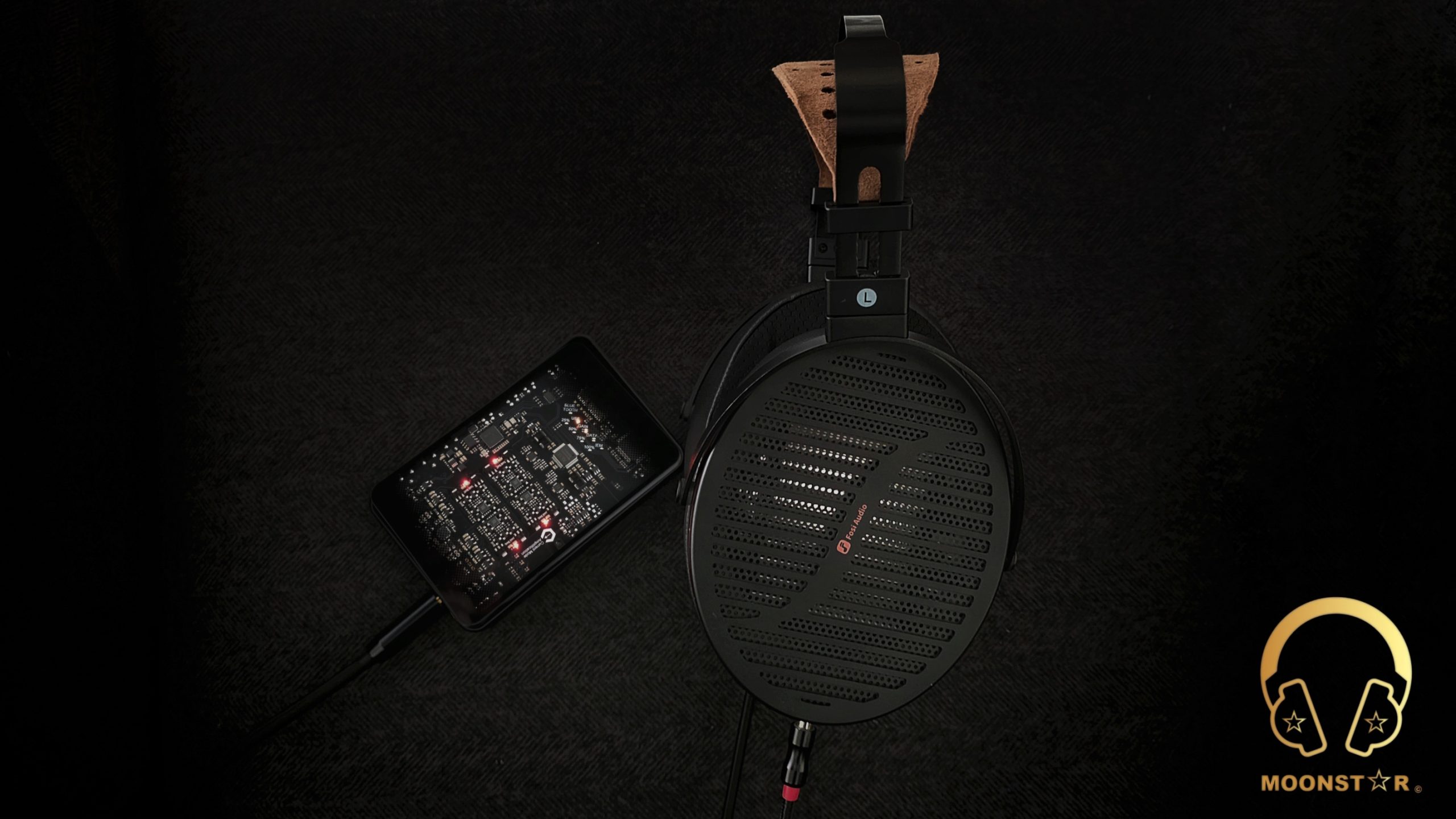
Albums & Tracks Used for this Review:
Vocal Jazz / Smooth Jazz
- Norah Jones – Come Away With Me (Flac 24bit/96kHz)
- Diana Krall – So Wonderful (DSF)
- Barry White – Just The Way You Are (Flac 24bit/48kHz)
- Isaac Hayes – Walk On By (Flac 16bit/44.1kHz)
- Sting – Englishman in New York (Flac 24bit/48kHz)
- Otto Liebert & Luna Negra – The River (Flac 24bit/192kHz)
- Ferit Odman – Look, Stop & Listen (Flac 24bit/192kHz)
- Charly Antolini – Duwadjuwandadu (Flac 24bit/192kHz)
Soul / R&B
- Aretha Franklin – I Say A Little Prayer (Flac 24bit/96kHz)
- Adele – My Little Love (Apple Lossless)
- George Michael – Don’t Let the Sun Go Down on Me (Flac 24bit/192kHz)
- Eric Clapton – Wonderful Tonight (Flac 24bit/96kHz)
Pop / Rock Classics
- Michael Jackson – Billie Jean (Flac 24bit/96kHz)
- Elton John – Rocket Man (Flac 24bit/96kHz)
- David Bowie – Heroes (Flac 24bit/192kHz)
- U2 – Sunday Bloody Sunday (Flac 16bit/44.1kHz)
- Lorde – Royals (Flac 24bit/48kHz)
- Dave Gahan – Kingdom (Apple Lossless)
Electronic / Experimental
- Daft Punk – Instant Crush (Flac 24bit/96kHz)
- Daft Punk – Doin’ it Right (Flac 24bit/96kHz)
- Bro Safari, UFO! – Drama (Apple Lossless)
- Armin Van Buuren – Vini Vici (Flac 16bit/44.1kHz)
- Yosi Horikawa – Bubbles (Apple Lossless)
- Toutant – Rebirth (Apple Lossless)
Alternative / Indie / Art Rock
- Radiohead – Live in Berlin “Album” (Apple Lossless)
- Radiohead – Pyramid Song (Apple Lossless)
- Muse – Hysteria (Flac 24bit/96kHz)
- Red Hot Chili Peppers – Nobody Weird Like Me (Flac 24bit/48kHz)
- Lunatic Soul – The Passage (Flac 16bit/44.1kHz)
- Portishead – It Could Be Sweet (Apple Lossless)
- Gogo Penguin – Raven (Flac 24bit/192kHz)
- Gogo Penguin – Murmuration (Flac 24bit/192kHz)
- Massive Attack – Angel (Flac 24bit/48kHz)
- Bear McCreary – Valkyries (Apple Lossless)
Classical / Orchestral
- Max Richter – On the Nature of Daylight (Flac 24bit/96kHz)
- Chopin – Nocturne No. 20 in C-Sharp Minor (Flac 16bit/44.1kHz)
- Clair de Lune – Claude Debussy (Apple Lossless)
- Tchaikovsky – Symphony No. 5 (Flac 16bit/44.1kHz)
- Vivaldi – Le Quattro Stagioni “The Four Seasons” (Apple Lossless)
- Fazıl Say – Nazım Oratoryosu (Live) (Flac 16bit/44.1kHz)
Jazz / Instrumental
- Miles Davis – So What (Apple Lossless)
World / Traditional
- Sertap Erener – Aşk (Flac 16bit/44.1kHz)
- Edith Piaf – Non Je Ne Regrette Rien (Flac 16bit/44.1kHz)
Metal / Progressive Rock
- Metallica – Dyers Eve (Flac 24bit/96kHz)
- Metallica – Sad but True (Flac 24bit/96kHz)
- Megadeth – Sweating Bullets (Apple Lossless)
- Opeth – Windowpane (Flac 16bit/44.1kHz)
- Deftones – My Own Summer (Shove It) (Flac 16bit/44.1kHz)
- Rush – Tom Sawyer (Flac 16bit/44.1kHz)
- Slayer – Angel of Death (Apple Lossless)
The Sound:
The Questyle SIGMA unit underwent a standard run in period of approximately 120 hours prior to any critical evaluation. This duration was utilized to ensure all internal electronic components had reached their stable operational parameters. All critical listening sessions were conducted using the high fidelity 4.4 mm balanced output. Testing spanned both the High and Low gain settings to evaluate the device’s performance across a range of headphone sensitivities. Additionally, the specific IEM mode was engaged exclusively when using sensitive in ear monitors, ensuring optimal noise floor management and appropriate power delivery for these transducers.
The resulting overall sound signature of the SIGMA can be characterized by its high transparency, effortless control, and naturally musical presentation. The device avoids artificial coloration or undue emphasis in any specific frequency range. Instead, the SIGMA delivers the music with remarkable clarity and strong dynamic expression. A key technical achievement is the presentation of a perceptually black background, which effectively minimizes distractions and allows the finest microdetails and subtle textural nuances to emerge with high visibility and minimal listening fatigue. This combination of technical finesse and musical balance suggests a device capable of driving diverse headphone loads while maintaining sonic integrity.
Now, let’s look at the details.
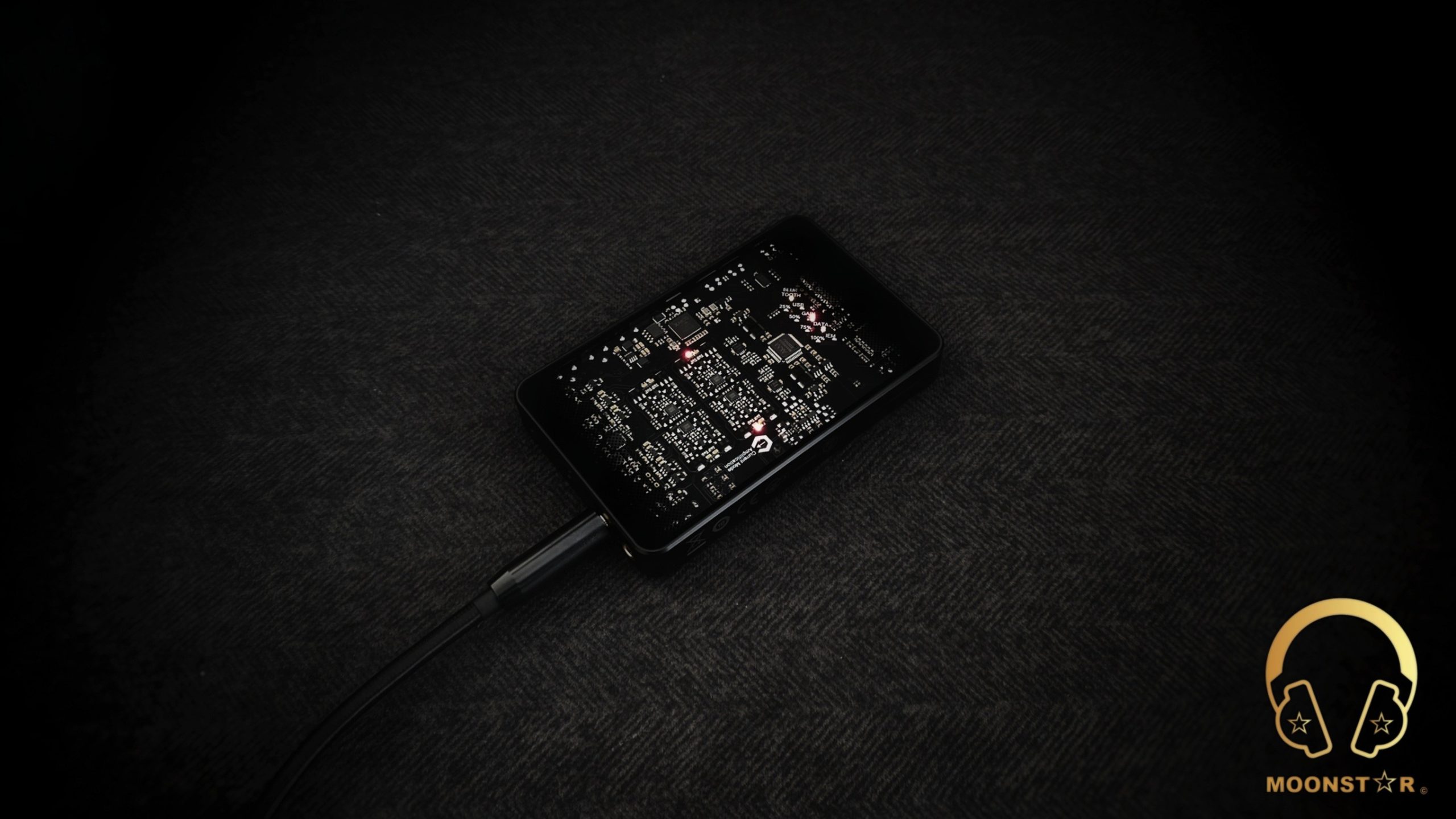
Bass:
The low frequency performance of the SIGMA shows competence across several technical aspects: extension, textural detail, speed, and overall dynamic impact. Sub bass frequencies reach deep with solid weight and well controlled decay, contributing to a substantial presence. When the SIGMA is used with the Oriveti OH700VB, which already features a full and warm low end signature, it introduces refinement and articulation without compromising the headphone’s characteristic richness. Kick drums deliver a clean impact, electronic bass lines have a clear physical presence, and acoustic double bass notes exhibit a natural grit and woody texture that sounds convincing. The low end remains composed, avoiding noticeable bloat or mid bass spill, even during louder listening sessions.
When paired with the Westone MACH 80, a monitor known for its quick and relatively neutral bass character, the SIGMA demonstrates its capability for effective layering and transient speed. Sub bass extension is strong among portable sources, creating a sense of palpable pressure and air movement in well recorded tracks. The transition between the sub bass and mid bass regions is handled smoothly, with minimal smearing or congestion observed. This aids in allowing complex rhythmic patterns and multi layered electronic arrangements to maintain distinct separation and definition.
Driving planar magnetic headphones, such as the HiFiMAN Sundara CB, utilizes the SIGMA’s considerable power reserves. The Sundara’s bass section acquires greater weight, texture, and impact compared to its sound from many standard portable sources, while retaining the quick attack and decay characteristic of planar drivers. With the power demanding FOSI i5 dynamic driver headphone, the improvement is noticeable: the low end becomes firm, powerful, and richly textured, enhancing the headphone’s performance significantly. The SIGMA consistently maintains current delivery and control, regardless of the load’s power requirements.
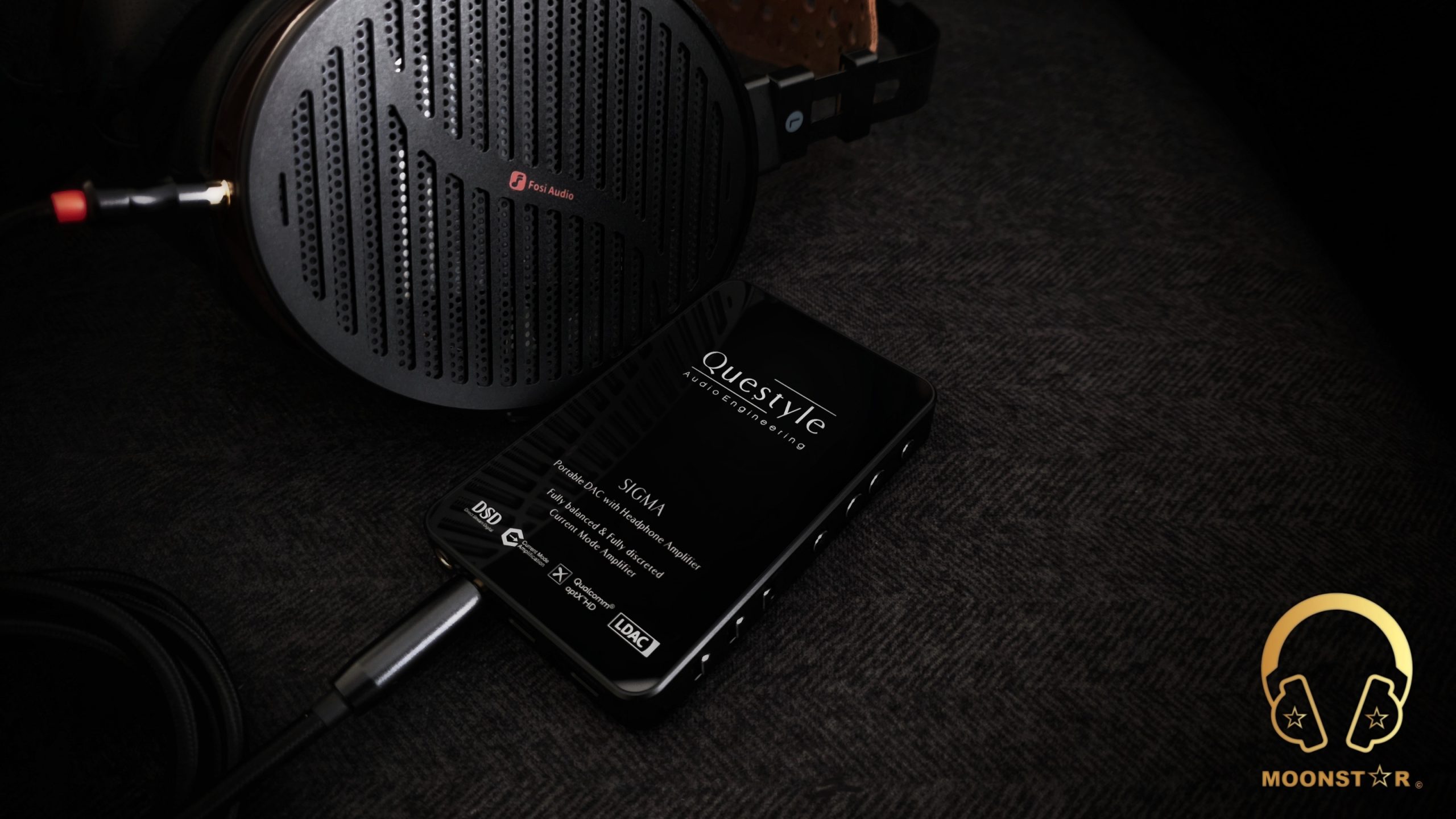
Midrange:
The midrange presentation is a strong point of the SIGMA, placing it competitively within the premium portable DAC/amplifier segment. It provides good transparency and detail retrieval, paired with a tonality that tends toward being natural and engaging. A touch of warmth helps maintain a smooth and musical character in the sound.
When paired with the Oriveti OH700VB, the SIGMA reproduces vocals with notable presence and substance. Female voices are rendered with a clarity and natural chest resonance, while male vocals possess appropriate weight, texture, and emotional depth. Subtle vocal nuances, such as breath control and timbre shifts, are easily discernible, creating a strong sense of realism. The OH700VB’s inherent warmth is complemented rather than masked, resulting in an intimate and highly engaging listening experience.
The more analytical and neutral Westone MACH 80 demonstrates the SIGMA’s exceptional resolution and microdetail retrieval capabilities. Piano notes are conveyed with accurate attack and harmonic complexity. String instruments reveal the texture of rosin and subtle bow transitions, while acoustic guitars sound very realistic, presenting believable body resonance and string vibration. The midrange avoids any hint of thinness or sterility; instead, it maintains a smooth, full bodied, and musically involving character.
Driving the HiFiMAN Sundara CB, the midrange expands into an impressively vast and three dimensional soundstage. Vocals are positioned precisely and distinctly separated from instrumental backing, contributing to a powerful sense of realism. The Sundara’s natural openness is enhanced, providing a presentation that competes well with many quality desktop setups. Similarly, the FOSI i5 scales effectively, gaining richness, dynamics, and tonal saturation that make genres like rock and vocal focused music very captivating. Across all tested pairings, the midrange maintains an excellent balance: it is present enough to feel intimate but avoids sounding aggressive or fatiguing.
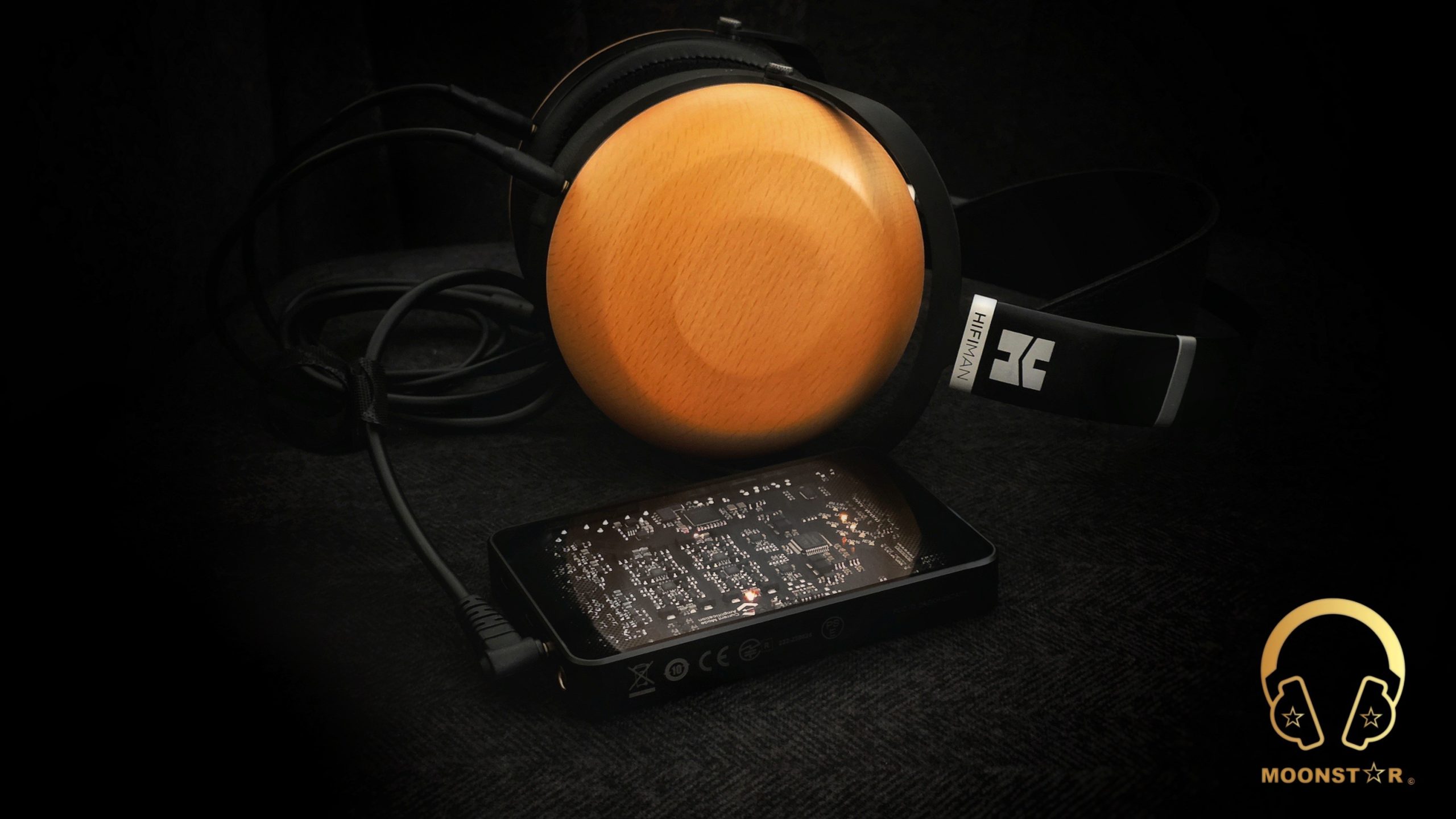
Treble:
The treble reproduction of the SIGMA is notably refined, achieving a high degree of sophistication for a portable device. It demonstrates excellent extension, airiness, and freedom from discernible grain, harshness, or artificial brilliance. The upper frequencies exhibit a smooth texture while maintaining strong resolution and sparkle. When used with the Oriveti OH700VB, which naturally presents a more relaxed top end, the SIGMA introduces an optimal amount of energy and extension. Cymbals shimmer with natural decay, and hi hats retain a crisp attack without sounding splashy.
The treble provides a delicate sense of illumination that enhances both spatial perception and detail retrieval. The resulting top end is cohesive, inviting, and precise, delivering subtle nuances with lifelike clarity and without causing listener fatigue. The Westone MACH 80, known for its quick and revealing treble signature, is effectively enhanced by the SIGMA. Microdetails are clearly rendered, such as the scrape of a brush on a snare drum or the harmonic ring of a triangle, yet these elements remain non fatiguing.
The SIGMA maintains precise control over sibilance and potentially peaky recordings, subtly smoothing them to ensure listenability while preserving the intended texture. This pairing highlights the device’s finesse with analytical transducers, transforming potentially clinical high frequencies into a sparkling, engaging extension that adds life to acoustic material. Driving the HiFiMAN Sundara CB, the treble acquires an almost holographic quality. Upper harmonics of violins and pianos float freely with impressive air and separation. The inherent speed of the planar magnetic driver is fully utilized, resulting in swift and effortless transients. Even in complex classical recordings, the SIGMA prevents the top end from becoming congested.
The FOSI i5, which can sometimes have a darker treble presentation, experiences a significant transformation with the SIGMA. Upper registers open up dramatically, revealing previously obscured layers of detail. Across all pairings, the SIGMA’s treble remains fatigue free, achieving a balanced presentation between analytical precision and musical enjoyment. This ensures the high frequencies effectively complement the music, providing a necessary sense of lift and openness across various genres.
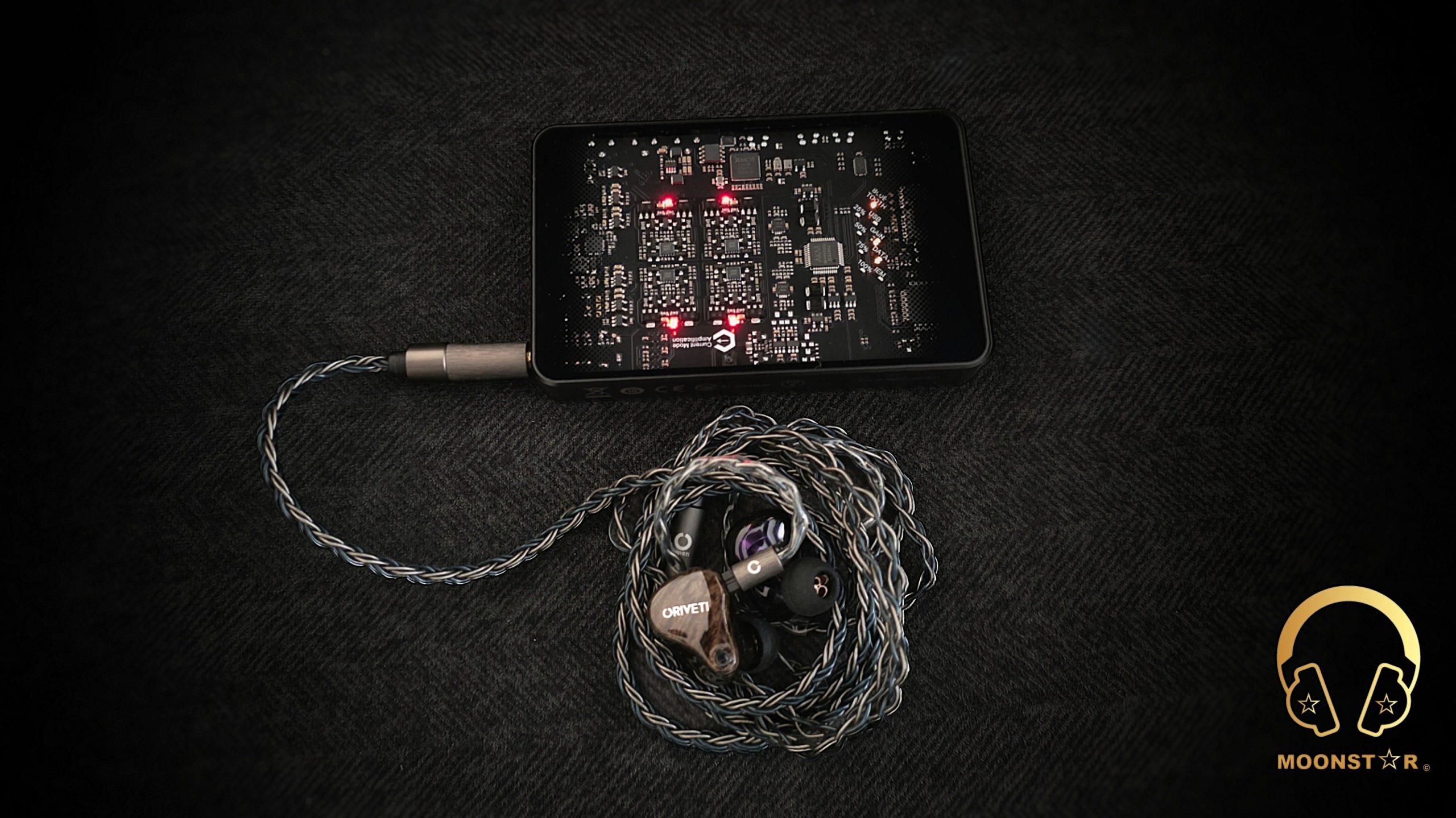
Soundstage & Imaging:
The SIGMA produces a soundstage that is wide, deep, and well organized, performing competitively within its class. Instrument placement is rendered accurately, and there is a good sense of space and air between elements. With the Sundara CB, the stage expands dimensionally, creating an immersive experience. The Westone MACH 80 delivers a presentation that is more intimate yet highly three dimensional, notable for its solid front to back depth. The Oriveti OH700VB offers a wide and tall stage, maintaining good separation despite its warmer tuning. Imaging remains consistently solid across all pairings, with minimal smearing or congestion even in dense passages.

Comparison:
Questyle SIGMA versus Questyle CMA18P:
Although both devices belong to the same Current Mode Amplification family and share the same core philosophy, the SIGMA represents a significant evolution over the excellent, time-tested CMA18P in almost every aspect of performance.
The most immediately noticeable difference, especially with high-sensitivity In-Ear Monitors (IEMs), is the refined noise floor of the SIGMA. Thanks to the dedicated IEM/HP OUT hardware switch and a modernized power supply design, the background is remarkably quiet even with multi-BA or EST-driver IEMs. The CMA18P was considered very quiet for its generation and remains so with less sensitive headphones, but the SIGMA achieves an even deeper level of silence with the most sensitive loads. The CMA18P may show a barely perceptible hiss with these high-sensitivity models in complete silence, whereas the SIGMA remains silent, making it an ideal companion for critical listening and late-night sessions where a pitch-black background is paramount.
Battery life is another clear area of progress for the SIGMA: real-world usage consistently exceeds 12 hours (often reaching 13-14 hours at moderate volume). This provides greater endurance compared to the CMA18P’s respectable 9-10 hours under similar conditions. This extended playback time makes the SIGMA noticeably more practical for long international flights or full-day outings without the pressure of needing an immediate recharge.
Sonically, the SIGMA delivers a step-up in control and definition. Bass on the SIGMA is deeper, notably tighter, faster, and more highly textured. While the CMA18P offers a slightly warmer and more musical low end, the SIGMA provides a level of authority and grip that feels closer to a dedicated desktop amplifier. Using demanding planar magnetic headphones, such as the HiFiMAN Sundara CB, the SIGMA demonstrates improved management of transients and impact.
The midrange of the SIGMA is distinctly more transparent and offers enhanced resolution and emotional connection. Vocals and instruments possess greater body, better spatial separation, and a naturally articulate timbre. The CMA18P’s midrange is highly enjoyable, but the SIGMA presents the music with a subtlety and detail that takes the performance to the next level, especially evident with highly resolving IEMs like the Westone MACH 80.
Treble extension, air, and overall refinement are distinctly progressed on the SIGMA. Where the CMA18P provides a smooth and integrated top end, the SIGMA offers greater sparkle, enhanced decay, and richer ambient information, contributing to a genuinely high-end listening experience.
The soundstage size, depth, and imaging precision are noticeably larger and more finely tuned on the SIGMA. Furthermore, overall dynamics, encompassing both powerful macro-hits and delicate micro-nuances, are conveyed with greater explosiveness and subtlety.
In short, the SIGMA is not just an incremental refinement; it is a comprehensive new generation that successfully advances the CMA18P’s legacy across noise performance, battery longevity, power management, and all crucial aspects of sonic fidelity.
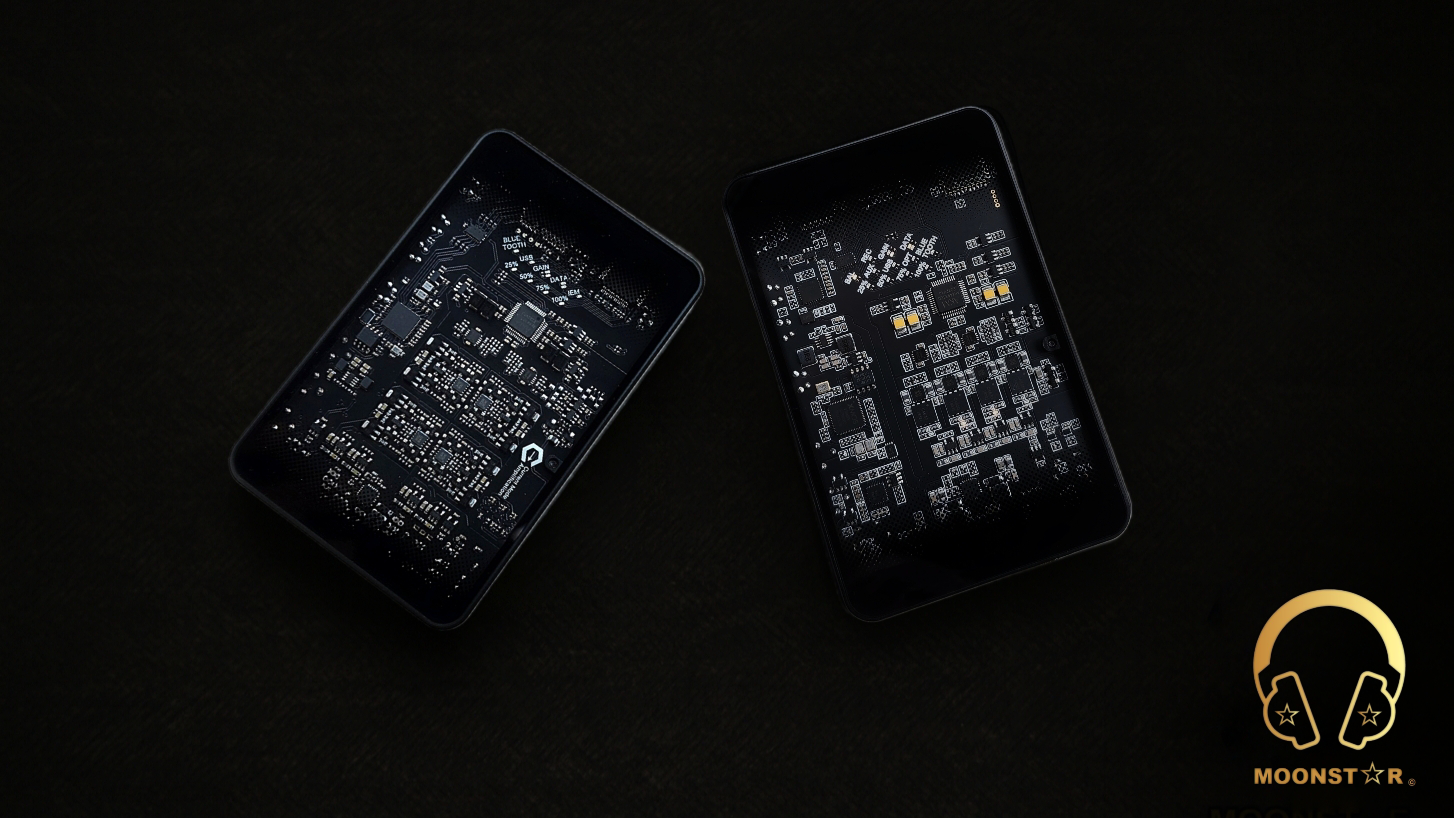
Conclusion:
The Questyle SIGMA demonstrates careful engineering aimed at delivering high‑resolution audio in a portable yet durable design. Its use of the AK4493 DAC and Current Mode Amplifier architecture provides desktop‑class decoding performance, while the transparent construction and retro‑inspired LED accents contribute to both aesthetics and functionality.
Build quality is solid, controls are intuitive, and the available outputs support a variety of listening setups. The device focuses on signal integrity and usability, which makes its performance consistent and reliable.
At the same time, the SIGMA positions itself as a genuine reference‑grade portable DAC/Amplifier. It combines transparency, strong power delivery (up to 1200mW), a silent background, and refined construction to create a solution that adapts equally well to sensitive IEMs and demanding full‑size headphones. This ability to scale across different transducers highlights its versatility without overstating its scope.
Overall, the SIGMA stands as a precise and well‑executed audio product that balances technical capability with thoughtful design, offering desktop‑level performance in an ultra‑compact form factor.

Pros & Cons:
- + Reference‑grade audio performance with AK4493 DAC and CMA architecture
- + Scales well with sensitive IEMs and full‑size headphones (HP/IEM Switch)
- + Solid build quality with aviation‑grade aluminum and glass
- + Transparent design allows a clear view of internal PCB and components
- + Retro‑inspired LED accents enhance aesthetics and usability
- + Versatile outputs with 3.5 mm single‑ended and 4.4 mm balanced
- + Charging while listening ensures uninterrupted playback
- – Lacks a dedicated app for PEQ and digital filter customization
- – LED indicators require memorizing color codes for different modes
- – Protective case not included, available only as a separate purchase
Thank you for the Read!

